Preparation of Phenyl Benzoate
VerifiedAdded on 2023/03/31
|20
|4192
|134
AI Summary
This article provides an introduction to the preparation of phenyl benzoate, including its background, objectives, and hypothesis. It also discusses the esterification process, equilibrium reactions, and different methods of preparing phenyl benzoate. The article concludes with a literature review on the topic. Find study material and solved assignments on Desklib.
Contribute Materials
Your contribution can guide someone’s learning journey. Share your
documents today.

TITLE: PREPARATION OF PHENYL BENZOATE
Secure Best Marks with AI Grader
Need help grading? Try our AI Grader for instant feedback on your assignments.
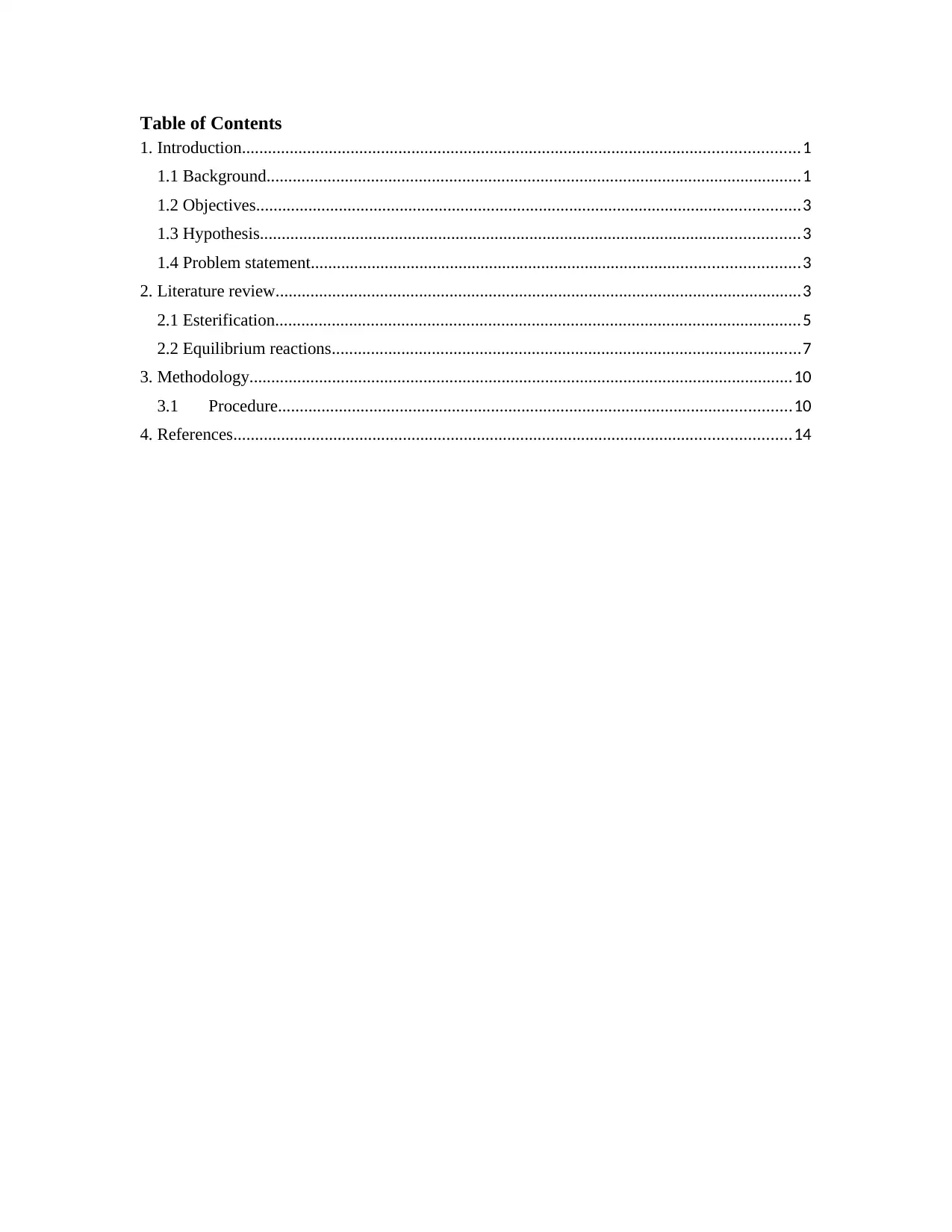
Table of Contents
1. Introduction................................................................................................................................1
1.1 Background...........................................................................................................................1
1.2 Objectives.............................................................................................................................3
1.3 Hypothesis............................................................................................................................3
1.4 Problem statement................................................................................................................3
2. Literature review.........................................................................................................................3
2.1 Esterification.........................................................................................................................5
2.2 Equilibrium reactions............................................................................................................7
3. Methodology.............................................................................................................................10
3.1 Procedure......................................................................................................................10
4. References................................................................................................................................14
1. Introduction................................................................................................................................1
1.1 Background...........................................................................................................................1
1.2 Objectives.............................................................................................................................3
1.3 Hypothesis............................................................................................................................3
1.4 Problem statement................................................................................................................3
2. Literature review.........................................................................................................................3
2.1 Esterification.........................................................................................................................5
2.2 Equilibrium reactions............................................................................................................7
3. Methodology.............................................................................................................................10
3.1 Procedure......................................................................................................................10
4. References................................................................................................................................14
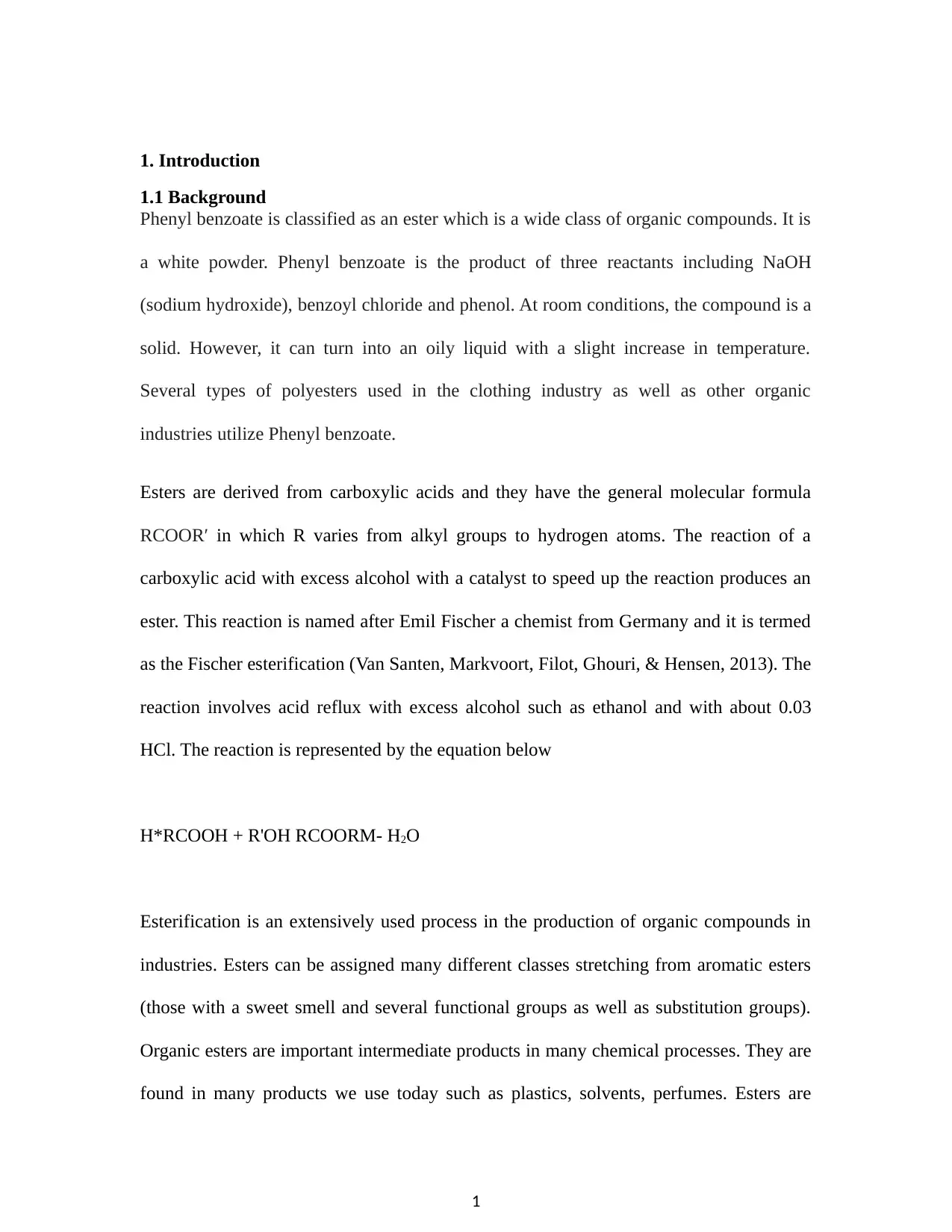
1. Introduction
1.1 Background
Phenyl benzoate is classified as an ester which is a wide class of organic compounds. It is
a white powder. Phenyl benzoate is the product of three reactants including NaOH
(sodium hydroxide), benzoyl chloride and phenol. At room conditions, the compound is a
solid. However, it can turn into an oily liquid with a slight increase in temperature.
Several types of polyesters used in the clothing industry as well as other organic
industries utilize Phenyl benzoate.
Esters are derived from carboxylic acids and they have the general molecular formula
RCOOR′ in which R varies from alkyl groups to hydrogen atoms. The reaction of a
carboxylic acid with excess alcohol with a catalyst to speed up the reaction produces an
ester. This reaction is named after Emil Fischer a chemist from Germany and it is termed
as the Fischer esterification (Van Santen, Markvoort, Filot, Ghouri, & Hensen, 2013). The
reaction involves acid reflux with excess alcohol such as ethanol and with about 0.03
HCl. The reaction is represented by the equation below
H*RCOOH + R'OH RCOORM- H2O
Esterification is an extensively used process in the production of organic compounds in
industries. Esters can be assigned many different classes stretching from aromatic esters
(those with a sweet smell and several functional groups as well as substitution groups).
Organic esters are important intermediate products in many chemical processes. They are
found in many products we use today such as plastics, solvents, perfumes. Esters are
1
1.1 Background
Phenyl benzoate is classified as an ester which is a wide class of organic compounds. It is
a white powder. Phenyl benzoate is the product of three reactants including NaOH
(sodium hydroxide), benzoyl chloride and phenol. At room conditions, the compound is a
solid. However, it can turn into an oily liquid with a slight increase in temperature.
Several types of polyesters used in the clothing industry as well as other organic
industries utilize Phenyl benzoate.
Esters are derived from carboxylic acids and they have the general molecular formula
RCOOR′ in which R varies from alkyl groups to hydrogen atoms. The reaction of a
carboxylic acid with excess alcohol with a catalyst to speed up the reaction produces an
ester. This reaction is named after Emil Fischer a chemist from Germany and it is termed
as the Fischer esterification (Van Santen, Markvoort, Filot, Ghouri, & Hensen, 2013). The
reaction involves acid reflux with excess alcohol such as ethanol and with about 0.03
HCl. The reaction is represented by the equation below
H*RCOOH + R'OH RCOORM- H2O
Esterification is an extensively used process in the production of organic compounds in
industries. Esters can be assigned many different classes stretching from aromatic esters
(those with a sweet smell and several functional groups as well as substitution groups).
Organic esters are important intermediate products in many chemical processes. They are
found in many products we use today such as plastics, solvents, perfumes. Esters are
1
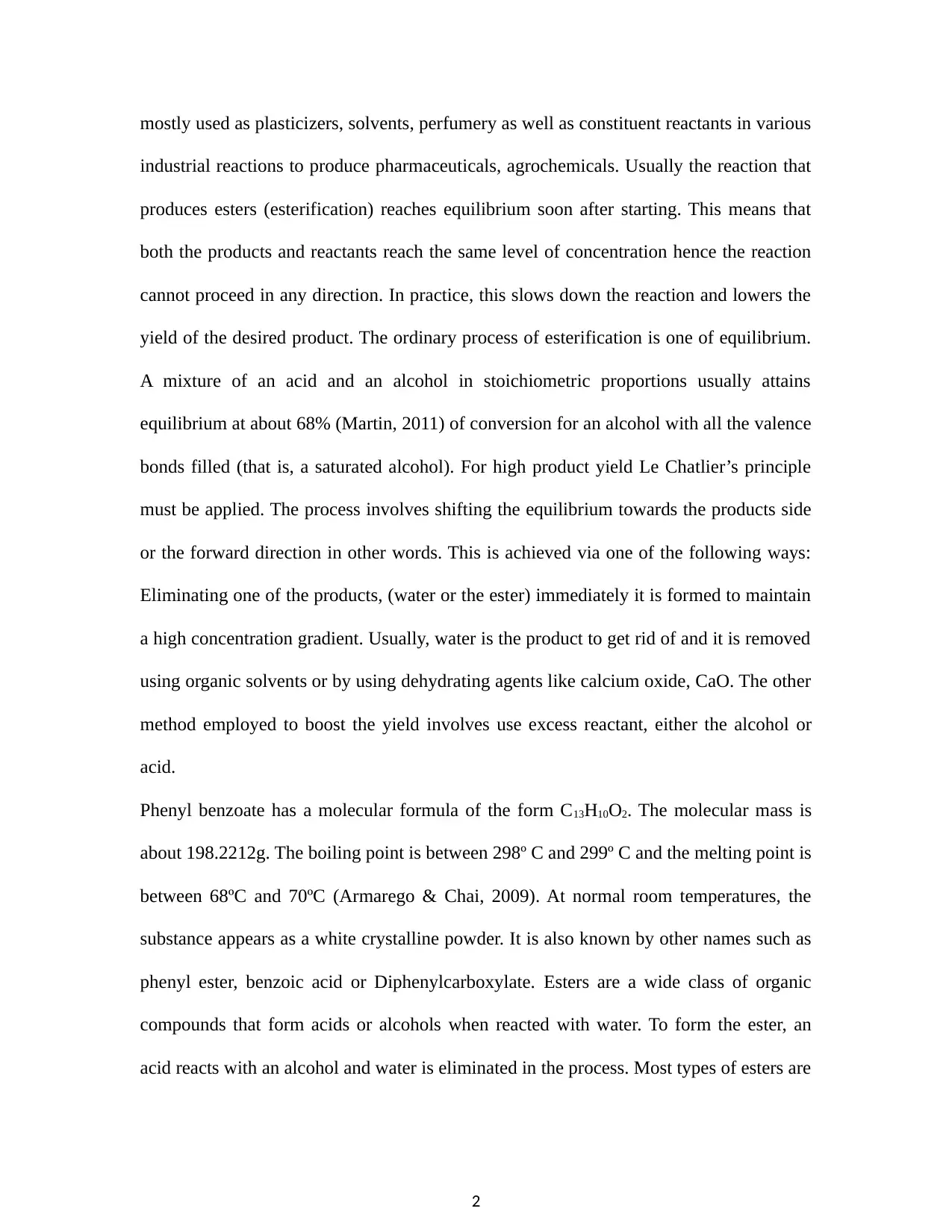
mostly used as plasticizers, solvents, perfumery as well as constituent reactants in various
industrial reactions to produce pharmaceuticals, agrochemicals. Usually the reaction that
produces esters (esterification) reaches equilibrium soon after starting. This means that
both the products and reactants reach the same level of concentration hence the reaction
cannot proceed in any direction. In practice, this slows down the reaction and lowers the
yield of the desired product. The ordinary process of esterification is one of equilibrium.
A mixture of an acid and an alcohol in stoichiometric proportions usually attains
equilibrium at about 68% (Martin, 2011) of conversion for an alcohol with all the valence
bonds filled (that is, a saturated alcohol). For high product yield Le Chatlier’s principle
must be applied. The process involves shifting the equilibrium towards the products side
or the forward direction in other words. This is achieved via one of the following ways:
Eliminating one of the products, (water or the ester) immediately it is formed to maintain
a high concentration gradient. Usually, water is the product to get rid of and it is removed
using organic solvents or by using dehydrating agents like calcium oxide, CaO. The other
method employed to boost the yield involves use excess reactant, either the alcohol or
acid.
Phenyl benzoate has a molecular formula of the form C13H10O2. The molecular mass is
about 198.2212g. The boiling point is between 298º C and 299º C and the melting point is
between 68ºC and 70ºC (Armarego & Chai, 2009). At normal room temperatures, the
substance appears as a white crystalline powder. It is also known by other names such as
phenyl ester, benzoic acid or Diphenylcarboxylate. Esters are a wide class of organic
compounds that form acids or alcohols when reacted with water. To form the ester, an
acid reacts with an alcohol and water is eliminated in the process. Most types of esters are
2
industrial reactions to produce pharmaceuticals, agrochemicals. Usually the reaction that
produces esters (esterification) reaches equilibrium soon after starting. This means that
both the products and reactants reach the same level of concentration hence the reaction
cannot proceed in any direction. In practice, this slows down the reaction and lowers the
yield of the desired product. The ordinary process of esterification is one of equilibrium.
A mixture of an acid and an alcohol in stoichiometric proportions usually attains
equilibrium at about 68% (Martin, 2011) of conversion for an alcohol with all the valence
bonds filled (that is, a saturated alcohol). For high product yield Le Chatlier’s principle
must be applied. The process involves shifting the equilibrium towards the products side
or the forward direction in other words. This is achieved via one of the following ways:
Eliminating one of the products, (water or the ester) immediately it is formed to maintain
a high concentration gradient. Usually, water is the product to get rid of and it is removed
using organic solvents or by using dehydrating agents like calcium oxide, CaO. The other
method employed to boost the yield involves use excess reactant, either the alcohol or
acid.
Phenyl benzoate has a molecular formula of the form C13H10O2. The molecular mass is
about 198.2212g. The boiling point is between 298º C and 299º C and the melting point is
between 68ºC and 70ºC (Armarego & Chai, 2009). At normal room temperatures, the
substance appears as a white crystalline powder. It is also known by other names such as
phenyl ester, benzoic acid or Diphenylcarboxylate. Esters are a wide class of organic
compounds that form acids or alcohols when reacted with water. To form the ester, an
acid reacts with an alcohol and water is eliminated in the process. Most types of esters are
2
Secure Best Marks with AI Grader
Need help grading? Try our AI Grader for instant feedback on your assignments.
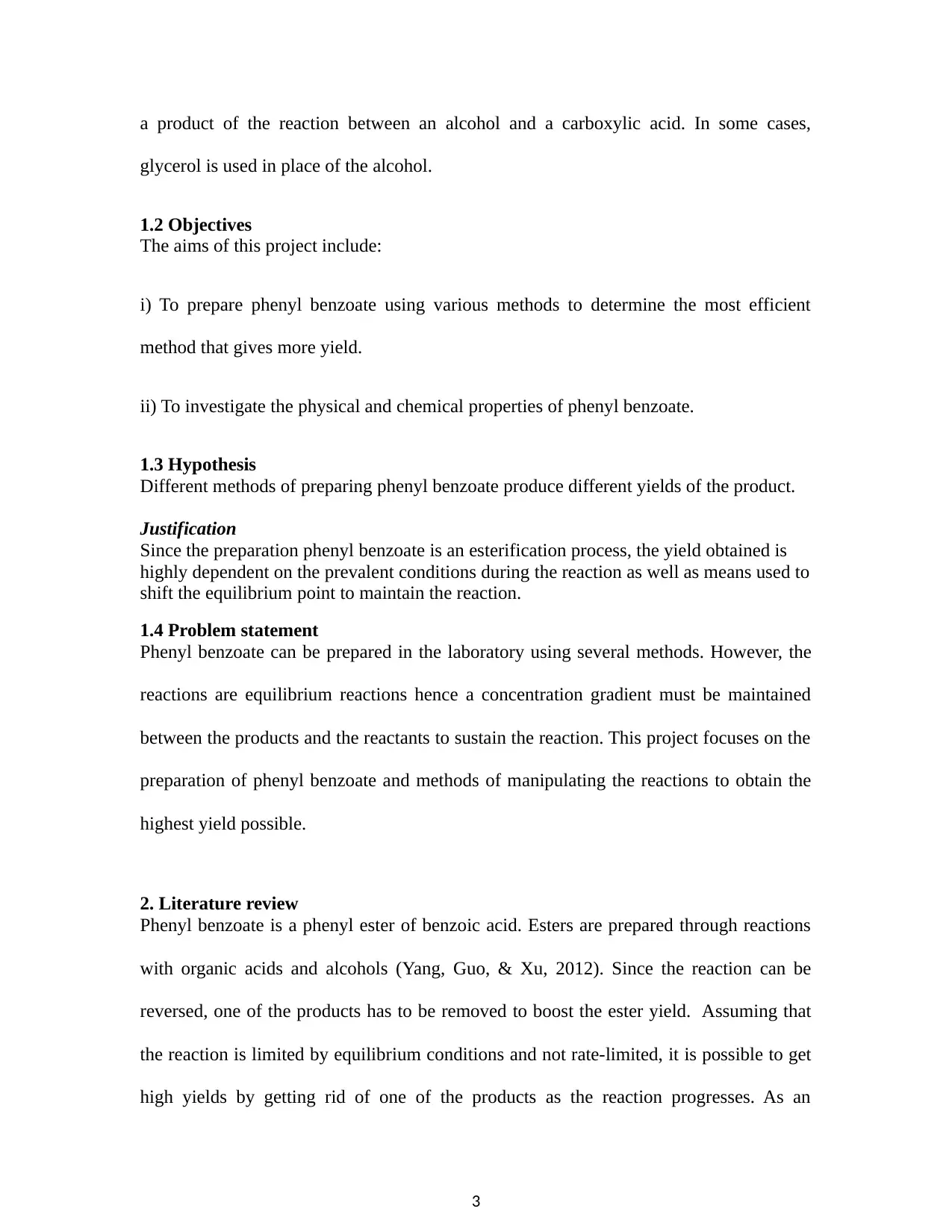
a product of the reaction between an alcohol and a carboxylic acid. In some cases,
glycerol is used in place of the alcohol.
1.2 Objectives
The aims of this project include:
i) To prepare phenyl benzoate using various methods to determine the most efficient
method that gives more yield.
ii) To investigate the physical and chemical properties of phenyl benzoate.
1.3 Hypothesis
Different methods of preparing phenyl benzoate produce different yields of the product.
Justification
Since the preparation phenyl benzoate is an esterification process, the yield obtained is
highly dependent on the prevalent conditions during the reaction as well as means used to
shift the equilibrium point to maintain the reaction.
1.4 Problem statement
Phenyl benzoate can be prepared in the laboratory using several methods. However, the
reactions are equilibrium reactions hence a concentration gradient must be maintained
between the products and the reactants to sustain the reaction. This project focuses on the
preparation of phenyl benzoate and methods of manipulating the reactions to obtain the
highest yield possible.
2. Literature review
Phenyl benzoate is a phenyl ester of benzoic acid. Esters are prepared through reactions
with organic acids and alcohols (Yang, Guo, & Xu, 2012). Since the reaction can be
reversed, one of the products has to be removed to boost the ester yield. Assuming that
the reaction is limited by equilibrium conditions and not rate-limited, it is possible to get
high yields by getting rid of one of the products as the reaction progresses. As an
3
glycerol is used in place of the alcohol.
1.2 Objectives
The aims of this project include:
i) To prepare phenyl benzoate using various methods to determine the most efficient
method that gives more yield.
ii) To investigate the physical and chemical properties of phenyl benzoate.
1.3 Hypothesis
Different methods of preparing phenyl benzoate produce different yields of the product.
Justification
Since the preparation phenyl benzoate is an esterification process, the yield obtained is
highly dependent on the prevalent conditions during the reaction as well as means used to
shift the equilibrium point to maintain the reaction.
1.4 Problem statement
Phenyl benzoate can be prepared in the laboratory using several methods. However, the
reactions are equilibrium reactions hence a concentration gradient must be maintained
between the products and the reactants to sustain the reaction. This project focuses on the
preparation of phenyl benzoate and methods of manipulating the reactions to obtain the
highest yield possible.
2. Literature review
Phenyl benzoate is a phenyl ester of benzoic acid. Esters are prepared through reactions
with organic acids and alcohols (Yang, Guo, & Xu, 2012). Since the reaction can be
reversed, one of the products has to be removed to boost the ester yield. Assuming that
the reaction is limited by equilibrium conditions and not rate-limited, it is possible to get
high yields by getting rid of one of the products as the reaction progresses. As an
3
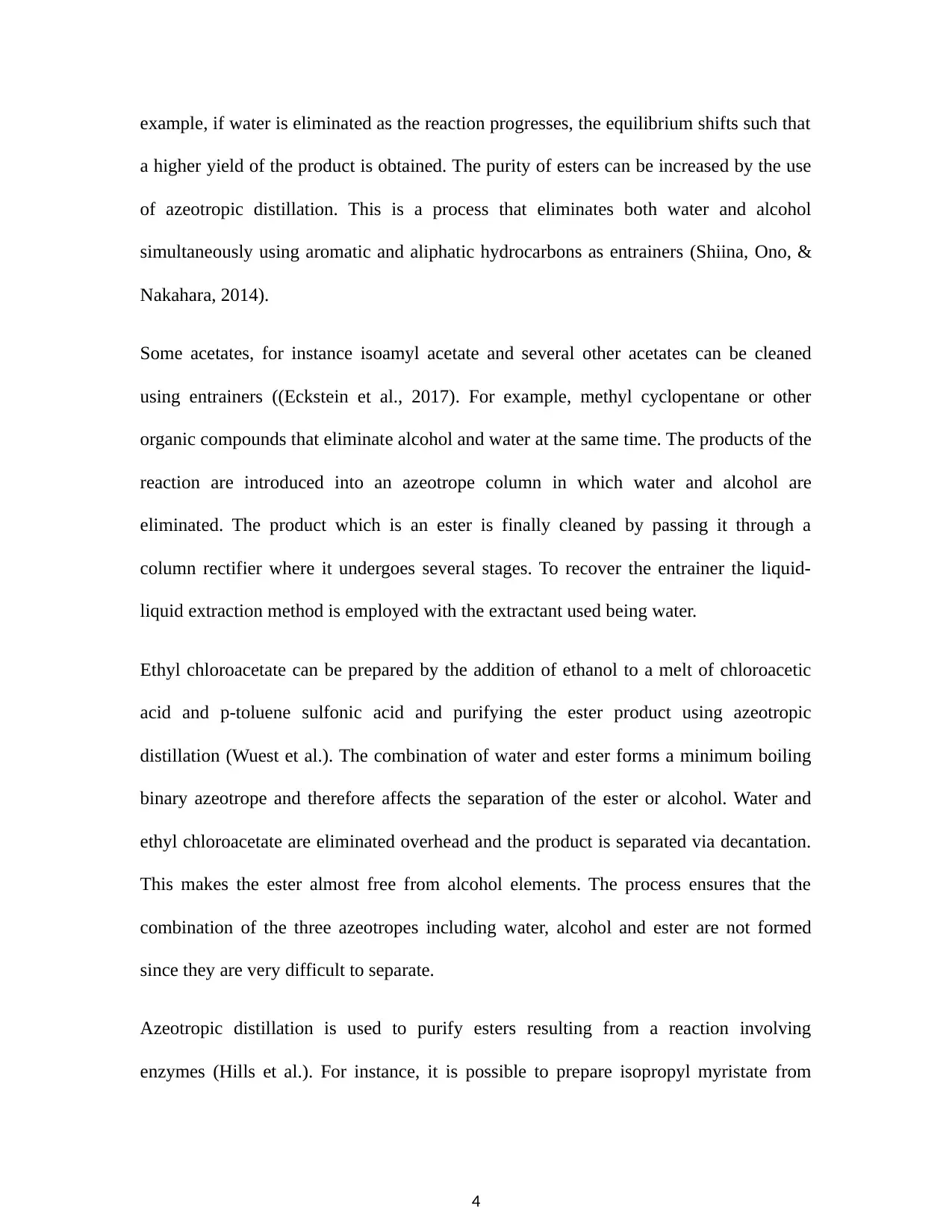
example, if water is eliminated as the reaction progresses, the equilibrium shifts such that
a higher yield of the product is obtained. The purity of esters can be increased by the use
of azeotropic distillation. This is a process that eliminates both water and alcohol
simultaneously using aromatic and aliphatic hydrocarbons as entrainers (Shiina, Ono, &
Nakahara, 2014).
Some acetates, for instance isoamyl acetate and several other acetates can be cleaned
using entrainers ((Eckstein et al., 2017). For example, methyl cyclopentane or other
organic compounds that eliminate alcohol and water at the same time. The products of the
reaction are introduced into an azeotrope column in which water and alcohol are
eliminated. The product which is an ester is finally cleaned by passing it through a
column rectifier where it undergoes several stages. To recover the entrainer the liquid-
liquid extraction method is employed with the extractant used being water.
Ethyl chloroacetate can be prepared by the addition of ethanol to a melt of chloroacetic
acid and p-toluene sulfonic acid and purifying the ester product using azeotropic
distillation (Wuest et al.). The combination of water and ester forms a minimum boiling
binary azeotrope and therefore affects the separation of the ester or alcohol. Water and
ethyl chloroacetate are eliminated overhead and the product is separated via decantation.
This makes the ester almost free from alcohol elements. The process ensures that the
combination of the three azeotropes including water, alcohol and ester are not formed
since they are very difficult to separate.
Azeotropic distillation is used to purify esters resulting from a reaction involving
enzymes (Hills et al.). For instance, it is possible to prepare isopropyl myristate from
4
a higher yield of the product is obtained. The purity of esters can be increased by the use
of azeotropic distillation. This is a process that eliminates both water and alcohol
simultaneously using aromatic and aliphatic hydrocarbons as entrainers (Shiina, Ono, &
Nakahara, 2014).
Some acetates, for instance isoamyl acetate and several other acetates can be cleaned
using entrainers ((Eckstein et al., 2017). For example, methyl cyclopentane or other
organic compounds that eliminate alcohol and water at the same time. The products of the
reaction are introduced into an azeotrope column in which water and alcohol are
eliminated. The product which is an ester is finally cleaned by passing it through a
column rectifier where it undergoes several stages. To recover the entrainer the liquid-
liquid extraction method is employed with the extractant used being water.
Ethyl chloroacetate can be prepared by the addition of ethanol to a melt of chloroacetic
acid and p-toluene sulfonic acid and purifying the ester product using azeotropic
distillation (Wuest et al.). The combination of water and ester forms a minimum boiling
binary azeotrope and therefore affects the separation of the ester or alcohol. Water and
ethyl chloroacetate are eliminated overhead and the product is separated via decantation.
This makes the ester almost free from alcohol elements. The process ensures that the
combination of the three azeotropes including water, alcohol and ester are not formed
since they are very difficult to separate.
Azeotropic distillation is used to purify esters resulting from a reaction involving
enzymes (Hills et al.). For instance, it is possible to prepare isopropyl myristate from
4
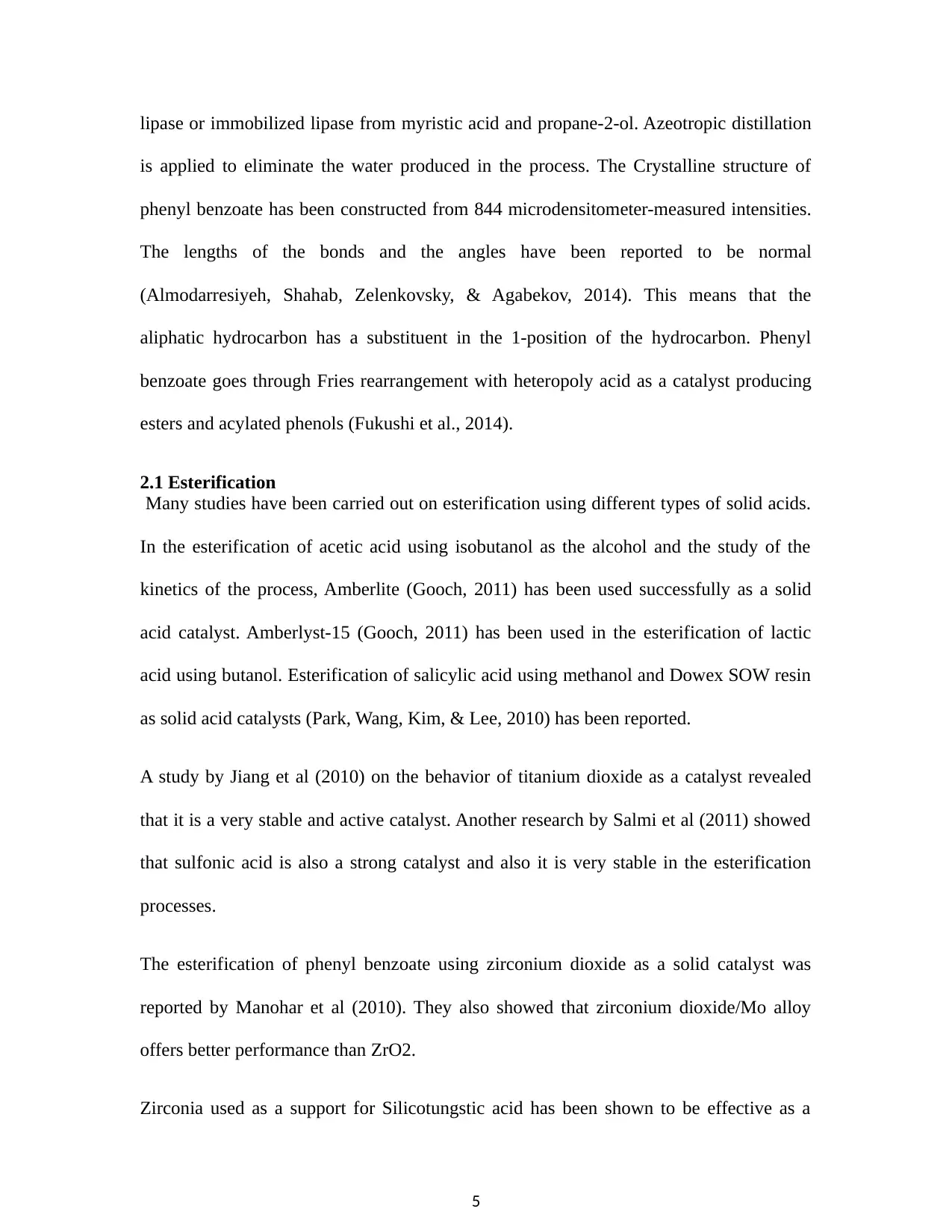
lipase or immobilized lipase from myristic acid and propane-2-ol. Azeotropic distillation
is applied to eliminate the water produced in the process. The Crystalline structure of
phenyl benzoate has been constructed from 844 microdensitometer-measured intensities.
The lengths of the bonds and the angles have been reported to be normal
(Almodarresiyeh, Shahab, Zelenkovsky, & Agabekov, 2014). This means that the
aliphatic hydrocarbon has a substituent in the 1-position of the hydrocarbon. Phenyl
benzoate goes through Fries rearrangement with heteropoly acid as a catalyst producing
esters and acylated phenols (Fukushi et al., 2014).
2.1 Esterification
Many studies have been carried out on esterification using different types of solid acids.
In the esterification of acetic acid using isobutanol as the alcohol and the study of the
kinetics of the process, Amberlite (Gooch, 2011) has been used successfully as a solid
acid catalyst. Amberlyst-15 (Gooch, 2011) has been used in the esterification of lactic
acid using butanol. Esterification of salicylic acid using methanol and Dowex SOW resin
as solid acid catalysts (Park, Wang, Kim, & Lee, 2010) has been reported.
A study by Jiang et al (2010) on the behavior of titanium dioxide as a catalyst revealed
that it is a very stable and active catalyst. Another research by Salmi et al (2011) showed
that sulfonic acid is also a strong catalyst and also it is very stable in the esterification
processes.
The esterification of phenyl benzoate using zirconium dioxide as a solid catalyst was
reported by Manohar et al (2010). They also showed that zirconium dioxide/Mo alloy
offers better performance than ZrO2.
Zirconia used as a support for Silicotungstic acid has been shown to be effective as a
5
is applied to eliminate the water produced in the process. The Crystalline structure of
phenyl benzoate has been constructed from 844 microdensitometer-measured intensities.
The lengths of the bonds and the angles have been reported to be normal
(Almodarresiyeh, Shahab, Zelenkovsky, & Agabekov, 2014). This means that the
aliphatic hydrocarbon has a substituent in the 1-position of the hydrocarbon. Phenyl
benzoate goes through Fries rearrangement with heteropoly acid as a catalyst producing
esters and acylated phenols (Fukushi et al., 2014).
2.1 Esterification
Many studies have been carried out on esterification using different types of solid acids.
In the esterification of acetic acid using isobutanol as the alcohol and the study of the
kinetics of the process, Amberlite (Gooch, 2011) has been used successfully as a solid
acid catalyst. Amberlyst-15 (Gooch, 2011) has been used in the esterification of lactic
acid using butanol. Esterification of salicylic acid using methanol and Dowex SOW resin
as solid acid catalysts (Park, Wang, Kim, & Lee, 2010) has been reported.
A study by Jiang et al (2010) on the behavior of titanium dioxide as a catalyst revealed
that it is a very stable and active catalyst. Another research by Salmi et al (2011) showed
that sulfonic acid is also a strong catalyst and also it is very stable in the esterification
processes.
The esterification of phenyl benzoate using zirconium dioxide as a solid catalyst was
reported by Manohar et al (2010). They also showed that zirconium dioxide/Mo alloy
offers better performance than ZrO2.
Zirconia used as a support for Silicotungstic acid has been shown to be effective as a
5
Paraphrase This Document
Need a fresh take? Get an instant paraphrase of this document with our AI Paraphraser
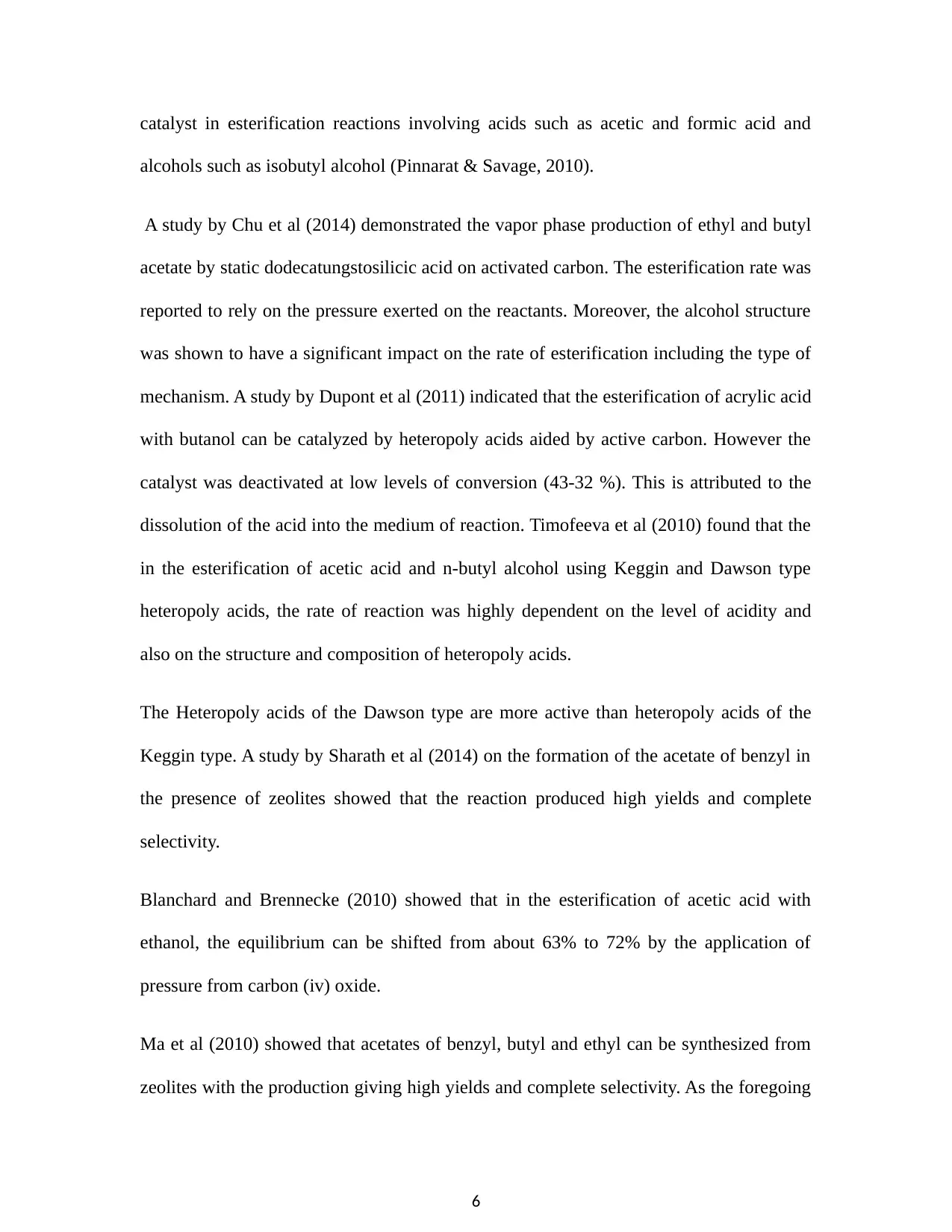
catalyst in esterification reactions involving acids such as acetic and formic acid and
alcohols such as isobutyl alcohol (Pinnarat & Savage, 2010).
A study by Chu et al (2014) demonstrated the vapor phase production of ethyl and butyl
acetate by static dodecatungstosilicic acid on activated carbon. The esterification rate was
reported to rely on the pressure exerted on the reactants. Moreover, the alcohol structure
was shown to have a significant impact on the rate of esterification including the type of
mechanism. A study by Dupont et al (2011) indicated that the esterification of acrylic acid
with butanol can be catalyzed by heteropoly acids aided by active carbon. However the
catalyst was deactivated at low levels of conversion (43-32 %). This is attributed to the
dissolution of the acid into the medium of reaction. Timofeeva et al (2010) found that the
in the esterification of acetic acid and n-butyl alcohol using Keggin and Dawson type
heteropoly acids, the rate of reaction was highly dependent on the level of acidity and
also on the structure and composition of heteropoly acids.
The Heteropoly acids of the Dawson type are more active than heteropoly acids of the
Keggin type. A study by Sharath et al (2014) on the formation of the acetate of benzyl in
the presence of zeolites showed that the reaction produced high yields and complete
selectivity.
Blanchard and Brennecke (2010) showed that in the esterification of acetic acid with
ethanol, the equilibrium can be shifted from about 63% to 72% by the application of
pressure from carbon (iv) oxide.
Ma et al (2010) showed that acetates of benzyl, butyl and ethyl can be synthesized from
zeolites with the production giving high yields and complete selectivity. As the foregoing
6
alcohols such as isobutyl alcohol (Pinnarat & Savage, 2010).
A study by Chu et al (2014) demonstrated the vapor phase production of ethyl and butyl
acetate by static dodecatungstosilicic acid on activated carbon. The esterification rate was
reported to rely on the pressure exerted on the reactants. Moreover, the alcohol structure
was shown to have a significant impact on the rate of esterification including the type of
mechanism. A study by Dupont et al (2011) indicated that the esterification of acrylic acid
with butanol can be catalyzed by heteropoly acids aided by active carbon. However the
catalyst was deactivated at low levels of conversion (43-32 %). This is attributed to the
dissolution of the acid into the medium of reaction. Timofeeva et al (2010) found that the
in the esterification of acetic acid and n-butyl alcohol using Keggin and Dawson type
heteropoly acids, the rate of reaction was highly dependent on the level of acidity and
also on the structure and composition of heteropoly acids.
The Heteropoly acids of the Dawson type are more active than heteropoly acids of the
Keggin type. A study by Sharath et al (2014) on the formation of the acetate of benzyl in
the presence of zeolites showed that the reaction produced high yields and complete
selectivity.
Blanchard and Brennecke (2010) showed that in the esterification of acetic acid with
ethanol, the equilibrium can be shifted from about 63% to 72% by the application of
pressure from carbon (iv) oxide.
Ma et al (2010) showed that acetates of benzyl, butyl and ethyl can be synthesized from
zeolites with the production giving high yields and complete selectivity. As the foregoing
6
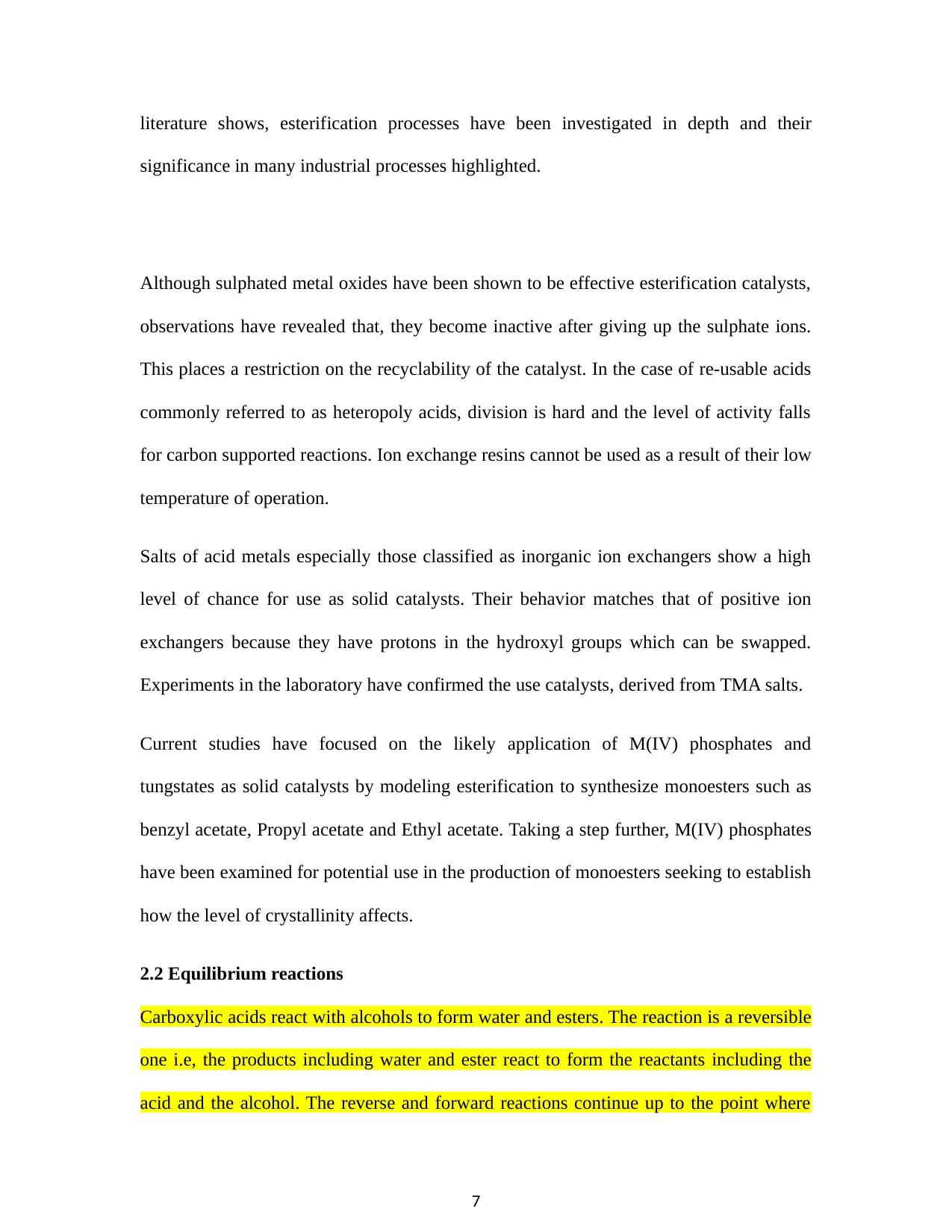
literature shows, esterification processes have been investigated in depth and their
significance in many industrial processes highlighted.
Although sulphated metal oxides have been shown to be effective esterification catalysts,
observations have revealed that, they become inactive after giving up the sulphate ions.
This places a restriction on the recyclability of the catalyst. In the case of re-usable acids
commonly referred to as heteropoly acids, division is hard and the level of activity falls
for carbon supported reactions. Ion exchange resins cannot be used as a result of their low
temperature of operation.
Salts of acid metals especially those classified as inorganic ion exchangers show a high
level of chance for use as solid catalysts. Their behavior matches that of positive ion
exchangers because they have protons in the hydroxyl groups which can be swapped.
Experiments in the laboratory have confirmed the use catalysts, derived from TMA salts.
Current studies have focused on the likely application of M(IV) phosphates and
tungstates as solid catalysts by modeling esterification to synthesize monoesters such as
benzyl acetate, Propyl acetate and Ethyl acetate. Taking a step further, M(IV) phosphates
have been examined for potential use in the production of monoesters seeking to establish
how the level of crystallinity affects.
2.2 Equilibrium reactions
Carboxylic acids react with alcohols to form water and esters. The reaction is a reversible
one i.e, the products including water and ester react to form the reactants including the
acid and the alcohol. The reverse and forward reactions continue up to the point where
7
significance in many industrial processes highlighted.
Although sulphated metal oxides have been shown to be effective esterification catalysts,
observations have revealed that, they become inactive after giving up the sulphate ions.
This places a restriction on the recyclability of the catalyst. In the case of re-usable acids
commonly referred to as heteropoly acids, division is hard and the level of activity falls
for carbon supported reactions. Ion exchange resins cannot be used as a result of their low
temperature of operation.
Salts of acid metals especially those classified as inorganic ion exchangers show a high
level of chance for use as solid catalysts. Their behavior matches that of positive ion
exchangers because they have protons in the hydroxyl groups which can be swapped.
Experiments in the laboratory have confirmed the use catalysts, derived from TMA salts.
Current studies have focused on the likely application of M(IV) phosphates and
tungstates as solid catalysts by modeling esterification to synthesize monoesters such as
benzyl acetate, Propyl acetate and Ethyl acetate. Taking a step further, M(IV) phosphates
have been examined for potential use in the production of monoesters seeking to establish
how the level of crystallinity affects.
2.2 Equilibrium reactions
Carboxylic acids react with alcohols to form water and esters. The reaction is a reversible
one i.e, the products including water and ester react to form the reactants including the
acid and the alcohol. The reverse and forward reactions continue up to the point where
7
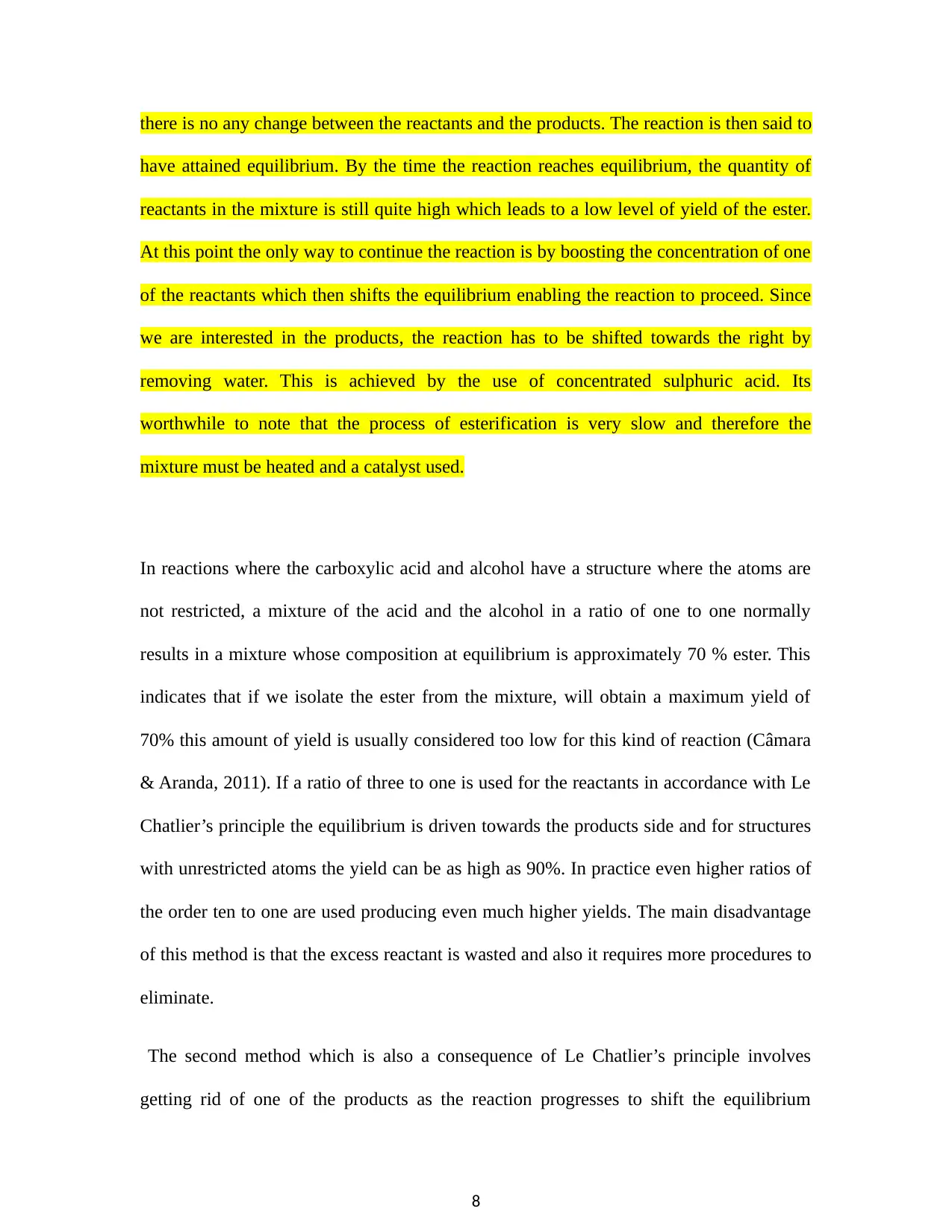
there is no any change between the reactants and the products. The reaction is then said to
have attained equilibrium. By the time the reaction reaches equilibrium, the quantity of
reactants in the mixture is still quite high which leads to a low level of yield of the ester.
At this point the only way to continue the reaction is by boosting the concentration of one
of the reactants which then shifts the equilibrium enabling the reaction to proceed. Since
we are interested in the products, the reaction has to be shifted towards the right by
removing water. This is achieved by the use of concentrated sulphuric acid. Its
worthwhile to note that the process of esterification is very slow and therefore the
mixture must be heated and a catalyst used.
In reactions where the carboxylic acid and alcohol have a structure where the atoms are
not restricted, a mixture of the acid and the alcohol in a ratio of one to one normally
results in a mixture whose composition at equilibrium is approximately 70 % ester. This
indicates that if we isolate the ester from the mixture, will obtain a maximum yield of
70% this amount of yield is usually considered too low for this kind of reaction (Câmara
& Aranda, 2011). If a ratio of three to one is used for the reactants in accordance with Le
Chatlier’s principle the equilibrium is driven towards the products side and for structures
with unrestricted atoms the yield can be as high as 90%. In practice even higher ratios of
the order ten to one are used producing even much higher yields. The main disadvantage
of this method is that the excess reactant is wasted and also it requires more procedures to
eliminate.
The second method which is also a consequence of Le Chatlier’s principle involves
getting rid of one of the products as the reaction progresses to shift the equilibrium
8
have attained equilibrium. By the time the reaction reaches equilibrium, the quantity of
reactants in the mixture is still quite high which leads to a low level of yield of the ester.
At this point the only way to continue the reaction is by boosting the concentration of one
of the reactants which then shifts the equilibrium enabling the reaction to proceed. Since
we are interested in the products, the reaction has to be shifted towards the right by
removing water. This is achieved by the use of concentrated sulphuric acid. Its
worthwhile to note that the process of esterification is very slow and therefore the
mixture must be heated and a catalyst used.
In reactions where the carboxylic acid and alcohol have a structure where the atoms are
not restricted, a mixture of the acid and the alcohol in a ratio of one to one normally
results in a mixture whose composition at equilibrium is approximately 70 % ester. This
indicates that if we isolate the ester from the mixture, will obtain a maximum yield of
70% this amount of yield is usually considered too low for this kind of reaction (Câmara
& Aranda, 2011). If a ratio of three to one is used for the reactants in accordance with Le
Chatlier’s principle the equilibrium is driven towards the products side and for structures
with unrestricted atoms the yield can be as high as 90%. In practice even higher ratios of
the order ten to one are used producing even much higher yields. The main disadvantage
of this method is that the excess reactant is wasted and also it requires more procedures to
eliminate.
The second method which is also a consequence of Le Chatlier’s principle involves
getting rid of one of the products as the reaction progresses to shift the equilibrium
8
Secure Best Marks with AI Grader
Need help grading? Try our AI Grader for instant feedback on your assignments.
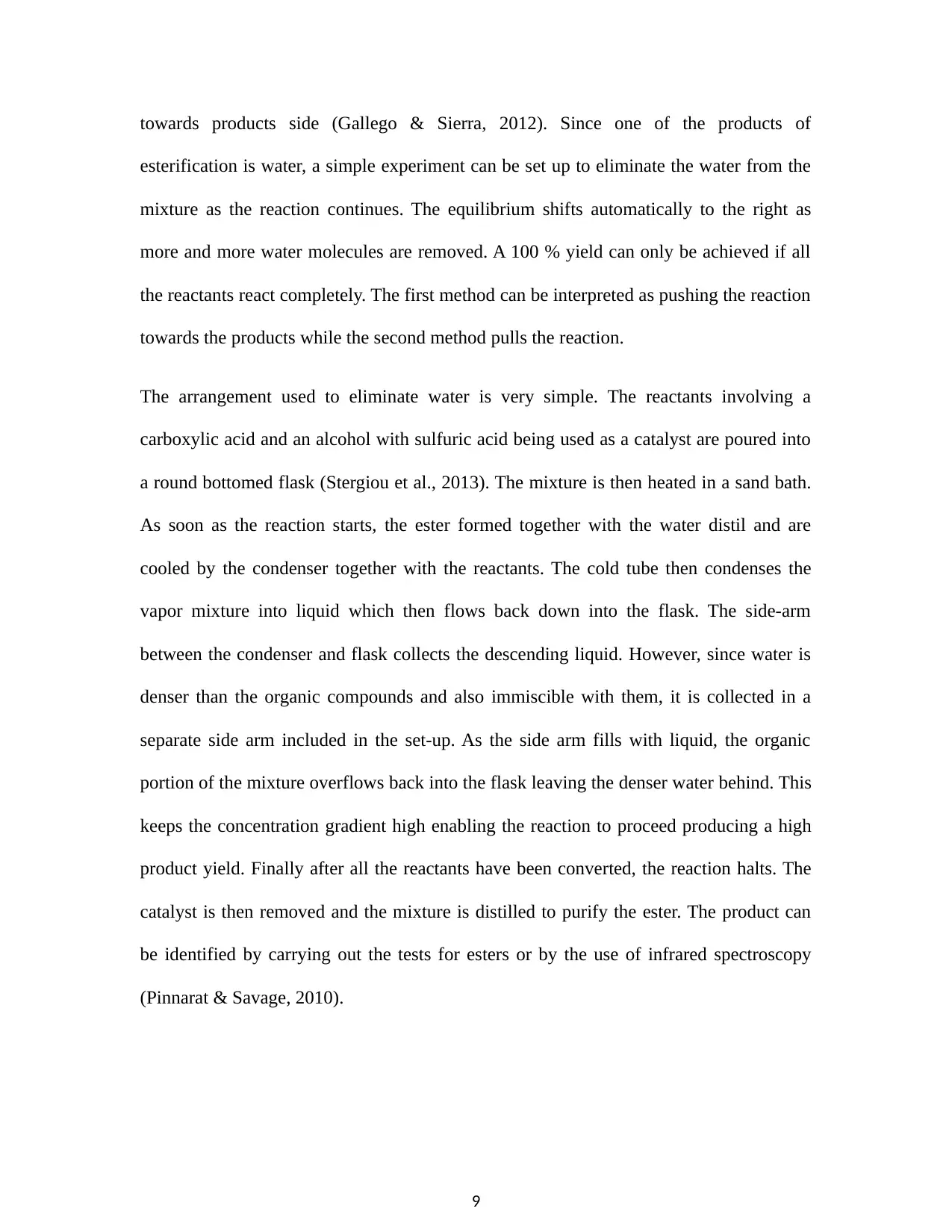
towards products side (Gallego & Sierra, 2012). Since one of the products of
esterification is water, a simple experiment can be set up to eliminate the water from the
mixture as the reaction continues. The equilibrium shifts automatically to the right as
more and more water molecules are removed. A 100 % yield can only be achieved if all
the reactants react completely. The first method can be interpreted as pushing the reaction
towards the products while the second method pulls the reaction.
The arrangement used to eliminate water is very simple. The reactants involving a
carboxylic acid and an alcohol with sulfuric acid being used as a catalyst are poured into
a round bottomed flask (Stergiou et al., 2013). The mixture is then heated in a sand bath.
As soon as the reaction starts, the ester formed together with the water distil and are
cooled by the condenser together with the reactants. The cold tube then condenses the
vapor mixture into liquid which then flows back down into the flask. The side-arm
between the condenser and flask collects the descending liquid. However, since water is
denser than the organic compounds and also immiscible with them, it is collected in a
separate side arm included in the set-up. As the side arm fills with liquid, the organic
portion of the mixture overflows back into the flask leaving the denser water behind. This
keeps the concentration gradient high enabling the reaction to proceed producing a high
product yield. Finally after all the reactants have been converted, the reaction halts. The
catalyst is then removed and the mixture is distilled to purify the ester. The product can
be identified by carrying out the tests for esters or by the use of infrared spectroscopy
(Pinnarat & Savage, 2010).
9
esterification is water, a simple experiment can be set up to eliminate the water from the
mixture as the reaction continues. The equilibrium shifts automatically to the right as
more and more water molecules are removed. A 100 % yield can only be achieved if all
the reactants react completely. The first method can be interpreted as pushing the reaction
towards the products while the second method pulls the reaction.
The arrangement used to eliminate water is very simple. The reactants involving a
carboxylic acid and an alcohol with sulfuric acid being used as a catalyst are poured into
a round bottomed flask (Stergiou et al., 2013). The mixture is then heated in a sand bath.
As soon as the reaction starts, the ester formed together with the water distil and are
cooled by the condenser together with the reactants. The cold tube then condenses the
vapor mixture into liquid which then flows back down into the flask. The side-arm
between the condenser and flask collects the descending liquid. However, since water is
denser than the organic compounds and also immiscible with them, it is collected in a
separate side arm included in the set-up. As the side arm fills with liquid, the organic
portion of the mixture overflows back into the flask leaving the denser water behind. This
keeps the concentration gradient high enabling the reaction to proceed producing a high
product yield. Finally after all the reactants have been converted, the reaction halts. The
catalyst is then removed and the mixture is distilled to purify the ester. The product can
be identified by carrying out the tests for esters or by the use of infrared spectroscopy
(Pinnarat & Savage, 2010).
9
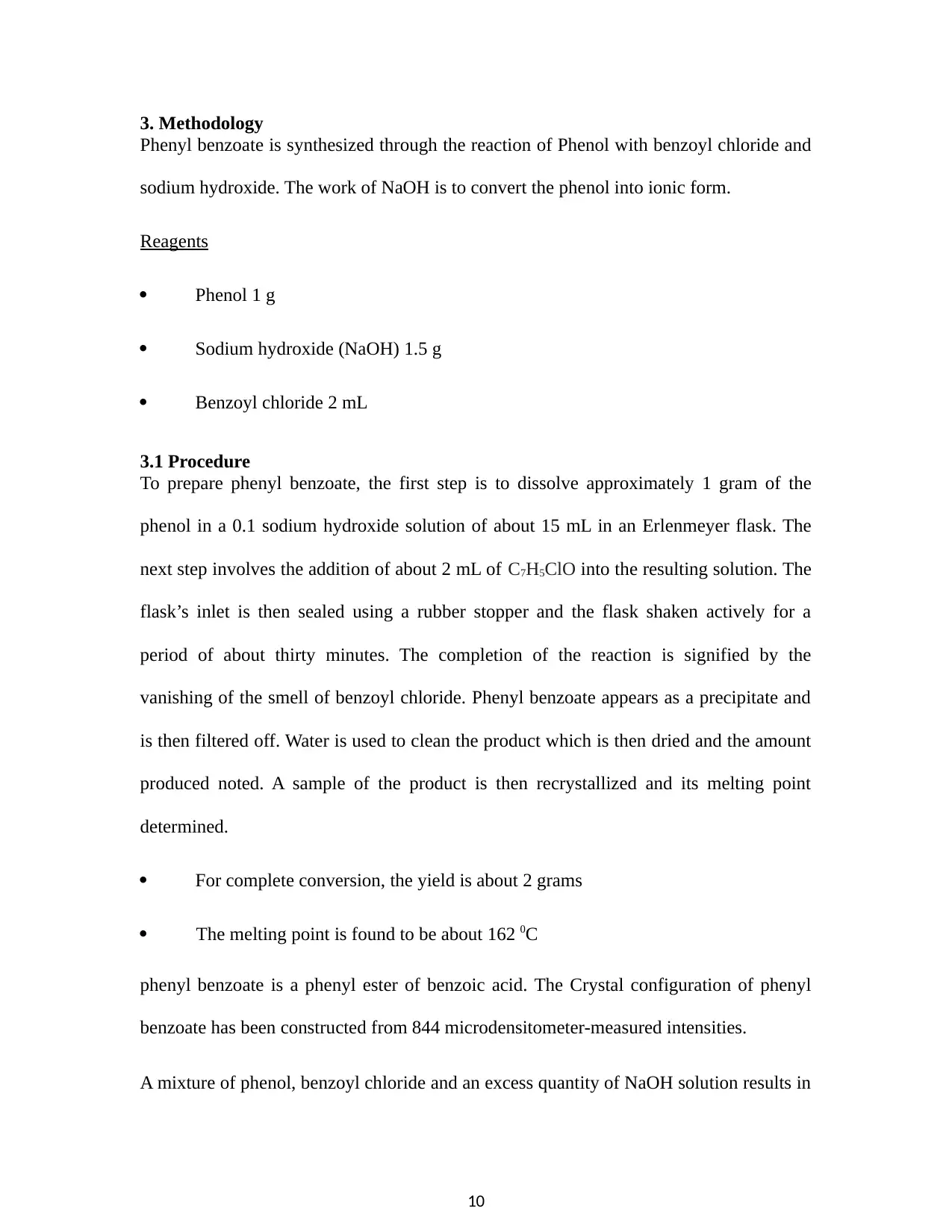
3. Methodology
Phenyl benzoate is synthesized through the reaction of Phenol with benzoyl chloride and
sodium hydroxide. The work of NaOH is to convert the phenol into ionic form.
Reagents
Phenol 1 g
Sodium hydroxide (NaOH) 1.5 g
Benzoyl chloride 2 mL
3.1 Procedure
To prepare phenyl benzoate, the first step is to dissolve approximately 1 gram of the
phenol in a 0.1 sodium hydroxide solution of about 15 mL in an Erlenmeyer flask. The
next step involves the addition of about 2 mL of C7H5ClO into the resulting solution. The
flask’s inlet is then sealed using a rubber stopper and the flask shaken actively for a
period of about thirty minutes. The completion of the reaction is signified by the
vanishing of the smell of benzoyl chloride. Phenyl benzoate appears as a precipitate and
is then filtered off. Water is used to clean the product which is then dried and the amount
produced noted. A sample of the product is then recrystallized and its melting point
determined.
For complete conversion, the yield is about 2 grams
The melting point is found to be about 162 0C
phenyl benzoate is a phenyl ester of benzoic acid. The Crystal configuration of phenyl
benzoate has been constructed from 844 microdensitometer-measured intensities.
A mixture of phenol, benzoyl chloride and an excess quantity of NaOH solution results in
10
Phenyl benzoate is synthesized through the reaction of Phenol with benzoyl chloride and
sodium hydroxide. The work of NaOH is to convert the phenol into ionic form.
Reagents
Phenol 1 g
Sodium hydroxide (NaOH) 1.5 g
Benzoyl chloride 2 mL
3.1 Procedure
To prepare phenyl benzoate, the first step is to dissolve approximately 1 gram of the
phenol in a 0.1 sodium hydroxide solution of about 15 mL in an Erlenmeyer flask. The
next step involves the addition of about 2 mL of C7H5ClO into the resulting solution. The
flask’s inlet is then sealed using a rubber stopper and the flask shaken actively for a
period of about thirty minutes. The completion of the reaction is signified by the
vanishing of the smell of benzoyl chloride. Phenyl benzoate appears as a precipitate and
is then filtered off. Water is used to clean the product which is then dried and the amount
produced noted. A sample of the product is then recrystallized and its melting point
determined.
For complete conversion, the yield is about 2 grams
The melting point is found to be about 162 0C
phenyl benzoate is a phenyl ester of benzoic acid. The Crystal configuration of phenyl
benzoate has been constructed from 844 microdensitometer-measured intensities.
A mixture of phenol, benzoyl chloride and an excess quantity of NaOH solution results in
10
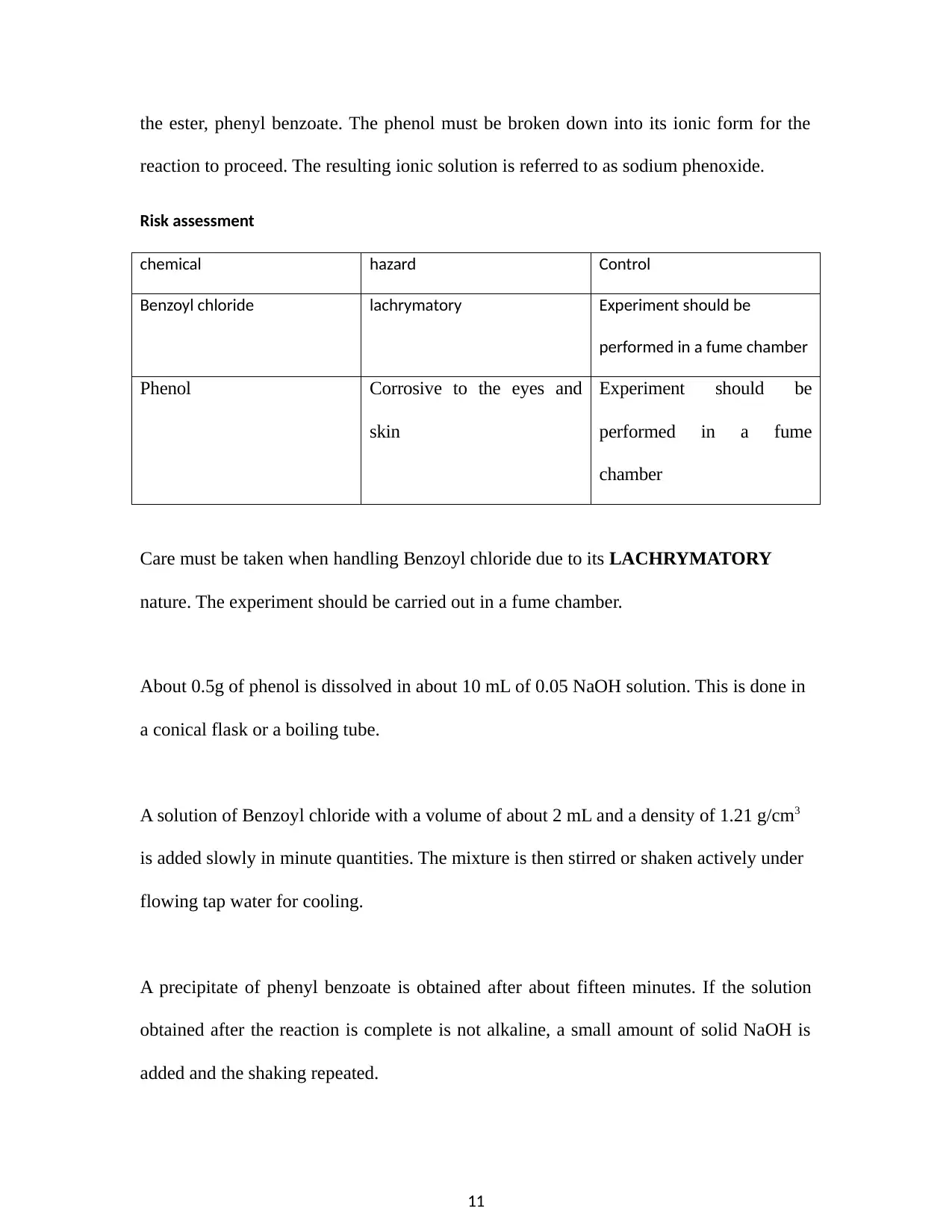
the ester, phenyl benzoate. The phenol must be broken down into its ionic form for the
reaction to proceed. The resulting ionic solution is referred to as sodium phenoxide.
Risk assessment
chemical hazard Control
Benzoyl chloride lachrymatory Experiment should be
performed in a fume chamber
Phenol Corrosive to the eyes and
skin
Experiment should be
performed in a fume
chamber
Care must be taken when handling Benzoyl chloride due to its LACHRYMATORY
nature. The experiment should be carried out in a fume chamber.
About 0.5g of phenol is dissolved in about 10 mL of 0.05 NaOH solution. This is done in
a conical flask or a boiling tube.
A solution of Benzoyl chloride with a volume of about 2 mL and a density of 1.21 g/cm3
is added slowly in minute quantities. The mixture is then stirred or shaken actively under
flowing tap water for cooling.
A precipitate of phenyl benzoate is obtained after about fifteen minutes. If the solution
obtained after the reaction is complete is not alkaline, a small amount of solid NaOH is
added and the shaking repeated.
11
reaction to proceed. The resulting ionic solution is referred to as sodium phenoxide.
Risk assessment
chemical hazard Control
Benzoyl chloride lachrymatory Experiment should be
performed in a fume chamber
Phenol Corrosive to the eyes and
skin
Experiment should be
performed in a fume
chamber
Care must be taken when handling Benzoyl chloride due to its LACHRYMATORY
nature. The experiment should be carried out in a fume chamber.
About 0.5g of phenol is dissolved in about 10 mL of 0.05 NaOH solution. This is done in
a conical flask or a boiling tube.
A solution of Benzoyl chloride with a volume of about 2 mL and a density of 1.21 g/cm3
is added slowly in minute quantities. The mixture is then stirred or shaken actively under
flowing tap water for cooling.
A precipitate of phenyl benzoate is obtained after about fifteen minutes. If the solution
obtained after the reaction is complete is not alkaline, a small amount of solid NaOH is
added and the shaking repeated.
11
Paraphrase This Document
Need a fresh take? Get an instant paraphrase of this document with our AI Paraphraser
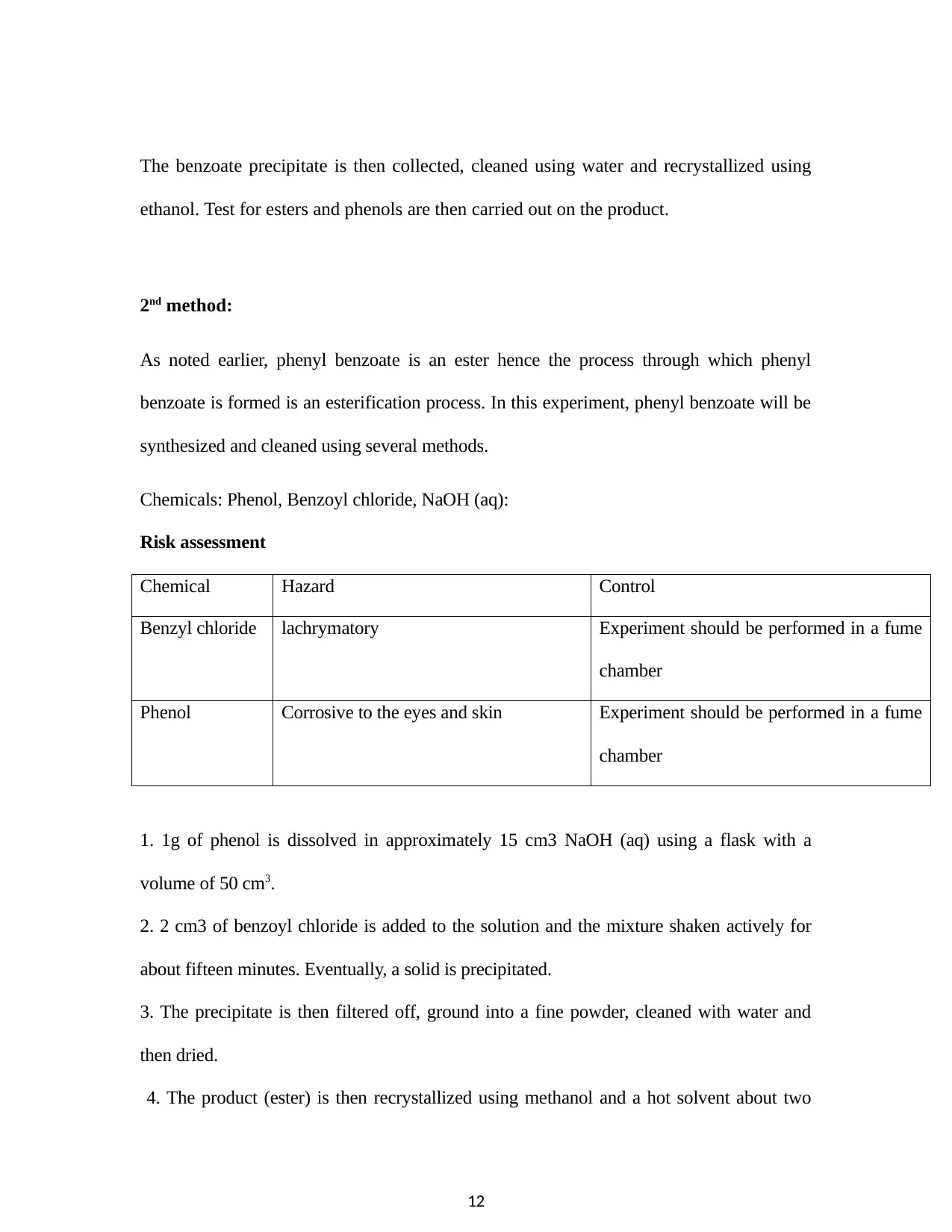
The benzoate precipitate is then collected, cleaned using water and recrystallized using
ethanol. Test for esters and phenols are then carried out on the product.
2nd method:
As noted earlier, phenyl benzoate is an ester hence the process through which phenyl
benzoate is formed is an esterification process. In this experiment, phenyl benzoate will be
synthesized and cleaned using several methods.
Chemicals: Phenol, Benzoyl chloride, NaOH (aq):
Risk assessment
Chemical Hazard Control
Benzyl chloride lachrymatory Experiment should be performed in a fume
chamber
Phenol Corrosive to the eyes and skin Experiment should be performed in a fume
chamber
1. 1g of phenol is dissolved in approximately 15 cm3 NaOH (aq) using a flask with a
volume of 50 cm3.
2. 2 cm3 of benzoyl chloride is added to the solution and the mixture shaken actively for
about fifteen minutes. Eventually, a solid is precipitated.
3. The precipitate is then filtered off, ground into a fine powder, cleaned with water and
then dried.
4. The product (ester) is then recrystallized using methanol and a hot solvent about two
12
ethanol. Test for esters and phenols are then carried out on the product.
2nd method:
As noted earlier, phenyl benzoate is an ester hence the process through which phenyl
benzoate is formed is an esterification process. In this experiment, phenyl benzoate will be
synthesized and cleaned using several methods.
Chemicals: Phenol, Benzoyl chloride, NaOH (aq):
Risk assessment
Chemical Hazard Control
Benzyl chloride lachrymatory Experiment should be performed in a fume
chamber
Phenol Corrosive to the eyes and skin Experiment should be performed in a fume
chamber
1. 1g of phenol is dissolved in approximately 15 cm3 NaOH (aq) using a flask with a
volume of 50 cm3.
2. 2 cm3 of benzoyl chloride is added to the solution and the mixture shaken actively for
about fifteen minutes. Eventually, a solid is precipitated.
3. The precipitate is then filtered off, ground into a fine powder, cleaned with water and
then dried.
4. The product (ester) is then recrystallized using methanol and a hot solvent about two
12
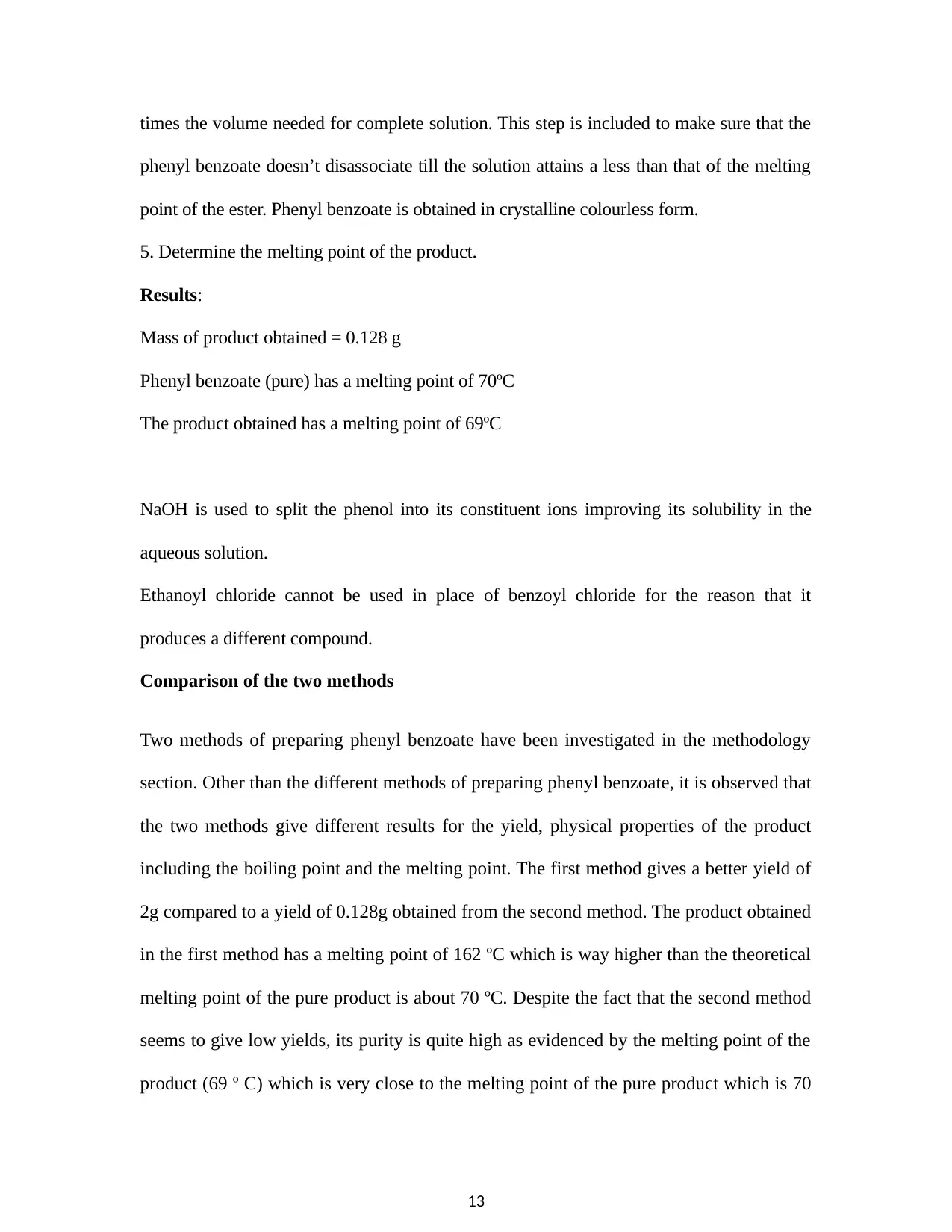
times the volume needed for complete solution. This step is included to make sure that the
phenyl benzoate doesn’t disassociate till the solution attains a less than that of the melting
point of the ester. Phenyl benzoate is obtained in crystalline colourless form.
5. Determine the melting point of the product.
Results:
Mass of product obtained = 0.128 g
Phenyl benzoate (pure) has a melting point of 70ºC
The product obtained has a melting point of 69ºC
NaOH is used to split the phenol into its constituent ions improving its solubility in the
aqueous solution.
Ethanoyl chloride cannot be used in place of benzoyl chloride for the reason that it
produces a different compound.
Comparison of the two methods
Two methods of preparing phenyl benzoate have been investigated in the methodology
section. Other than the different methods of preparing phenyl benzoate, it is observed that
the two methods give different results for the yield, physical properties of the product
including the boiling point and the melting point. The first method gives a better yield of
2g compared to a yield of 0.128g obtained from the second method. The product obtained
in the first method has a melting point of 162 ºC which is way higher than the theoretical
melting point of the pure product is about 70 ºC. Despite the fact that the second method
seems to give low yields, its purity is quite high as evidenced by the melting point of the
product (69 º C) which is very close to the melting point of the pure product which is 70
13
phenyl benzoate doesn’t disassociate till the solution attains a less than that of the melting
point of the ester. Phenyl benzoate is obtained in crystalline colourless form.
5. Determine the melting point of the product.
Results:
Mass of product obtained = 0.128 g
Phenyl benzoate (pure) has a melting point of 70ºC
The product obtained has a melting point of 69ºC
NaOH is used to split the phenol into its constituent ions improving its solubility in the
aqueous solution.
Ethanoyl chloride cannot be used in place of benzoyl chloride for the reason that it
produces a different compound.
Comparison of the two methods
Two methods of preparing phenyl benzoate have been investigated in the methodology
section. Other than the different methods of preparing phenyl benzoate, it is observed that
the two methods give different results for the yield, physical properties of the product
including the boiling point and the melting point. The first method gives a better yield of
2g compared to a yield of 0.128g obtained from the second method. The product obtained
in the first method has a melting point of 162 ºC which is way higher than the theoretical
melting point of the pure product is about 70 ºC. Despite the fact that the second method
seems to give low yields, its purity is quite high as evidenced by the melting point of the
product (69 º C) which is very close to the melting point of the pure product which is 70
13
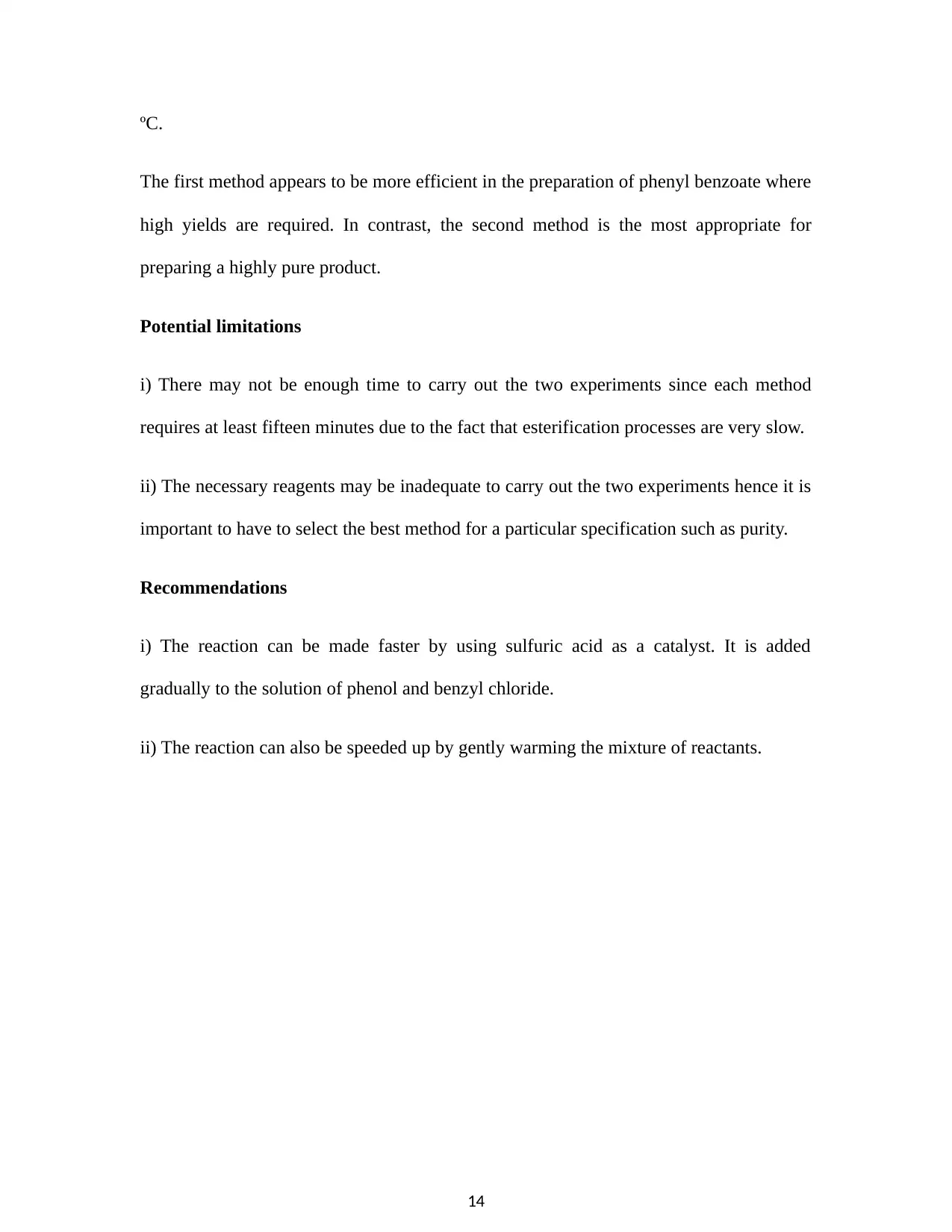
ºC.
The first method appears to be more efficient in the preparation of phenyl benzoate where
high yields are required. In contrast, the second method is the most appropriate for
preparing a highly pure product.
Potential limitations
i) There may not be enough time to carry out the two experiments since each method
requires at least fifteen minutes due to the fact that esterification processes are very slow.
ii) The necessary reagents may be inadequate to carry out the two experiments hence it is
important to have to select the best method for a particular specification such as purity.
Recommendations
i) The reaction can be made faster by using sulfuric acid as a catalyst. It is added
gradually to the solution of phenol and benzyl chloride.
ii) The reaction can also be speeded up by gently warming the mixture of reactants.
14
The first method appears to be more efficient in the preparation of phenyl benzoate where
high yields are required. In contrast, the second method is the most appropriate for
preparing a highly pure product.
Potential limitations
i) There may not be enough time to carry out the two experiments since each method
requires at least fifteen minutes due to the fact that esterification processes are very slow.
ii) The necessary reagents may be inadequate to carry out the two experiments hence it is
important to have to select the best method for a particular specification such as purity.
Recommendations
i) The reaction can be made faster by using sulfuric acid as a catalyst. It is added
gradually to the solution of phenol and benzyl chloride.
ii) The reaction can also be speeded up by gently warming the mixture of reactants.
14
Secure Best Marks with AI Grader
Need help grading? Try our AI Grader for instant feedback on your assignments.
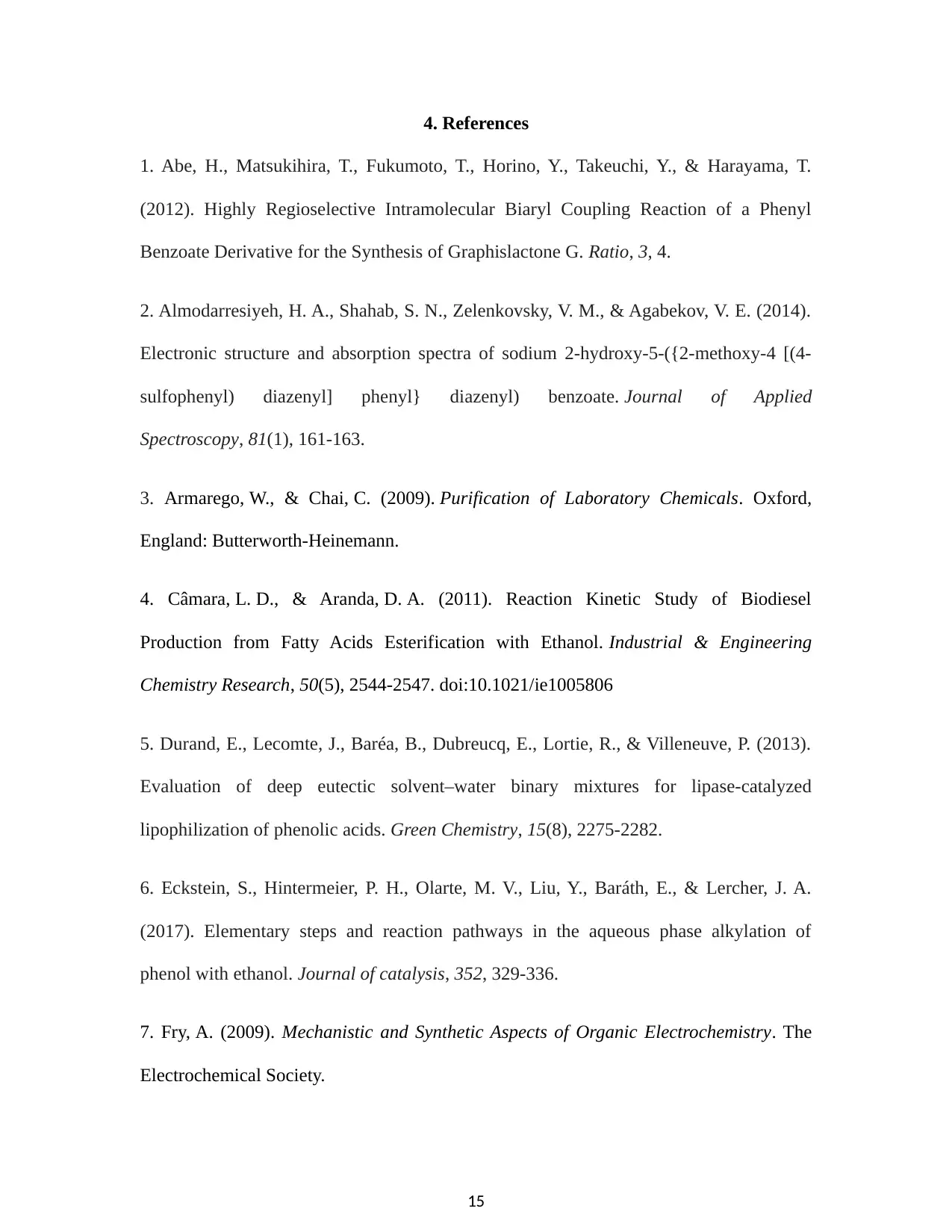
4. References
1. Abe, H., Matsukihira, T., Fukumoto, T., Horino, Y., Takeuchi, Y., & Harayama, T.
(2012). Highly Regioselective Intramolecular Biaryl Coupling Reaction of a Phenyl
Benzoate Derivative for the Synthesis of Graphislactone G. Ratio, 3, 4.
2. Almodarresiyeh, H. A., Shahab, S. N., Zelenkovsky, V. M., & Agabekov, V. E. (2014).
Electronic structure and absorption spectra of sodium 2-hydroxy-5-({2-methoxy-4 [(4-
sulfophenyl) diazenyl] phenyl} diazenyl) benzoate. Journal of Applied
Spectroscopy, 81(1), 161-163.
3. Armarego, W., & Chai, C. (2009). Purification of Laboratory Chemicals. Oxford,
England: Butterworth-Heinemann.
4. Câmara, L. D., & Aranda, D. A. (2011). Reaction Kinetic Study of Biodiesel
Production from Fatty Acids Esterification with Ethanol. Industrial & Engineering
Chemistry Research, 50(5), 2544-2547. doi:10.1021/ie1005806
5. Durand, E., Lecomte, J., Baréa, B., Dubreucq, E., Lortie, R., & Villeneuve, P. (2013).
Evaluation of deep eutectic solvent–water binary mixtures for lipase-catalyzed
lipophilization of phenolic acids. Green Chemistry, 15(8), 2275-2282.
6. Eckstein, S., Hintermeier, P. H., Olarte, M. V., Liu, Y., Baráth, E., & Lercher, J. A.
(2017). Elementary steps and reaction pathways in the aqueous phase alkylation of
phenol with ethanol. Journal of catalysis, 352, 329-336.
7. Fry, A. (2009). Mechanistic and Synthetic Aspects of Organic Electrochemistry. The
Electrochemical Society.
15
1. Abe, H., Matsukihira, T., Fukumoto, T., Horino, Y., Takeuchi, Y., & Harayama, T.
(2012). Highly Regioselective Intramolecular Biaryl Coupling Reaction of a Phenyl
Benzoate Derivative for the Synthesis of Graphislactone G. Ratio, 3, 4.
2. Almodarresiyeh, H. A., Shahab, S. N., Zelenkovsky, V. M., & Agabekov, V. E. (2014).
Electronic structure and absorption spectra of sodium 2-hydroxy-5-({2-methoxy-4 [(4-
sulfophenyl) diazenyl] phenyl} diazenyl) benzoate. Journal of Applied
Spectroscopy, 81(1), 161-163.
3. Armarego, W., & Chai, C. (2009). Purification of Laboratory Chemicals. Oxford,
England: Butterworth-Heinemann.
4. Câmara, L. D., & Aranda, D. A. (2011). Reaction Kinetic Study of Biodiesel
Production from Fatty Acids Esterification with Ethanol. Industrial & Engineering
Chemistry Research, 50(5), 2544-2547. doi:10.1021/ie1005806
5. Durand, E., Lecomte, J., Baréa, B., Dubreucq, E., Lortie, R., & Villeneuve, P. (2013).
Evaluation of deep eutectic solvent–water binary mixtures for lipase-catalyzed
lipophilization of phenolic acids. Green Chemistry, 15(8), 2275-2282.
6. Eckstein, S., Hintermeier, P. H., Olarte, M. V., Liu, Y., Baráth, E., & Lercher, J. A.
(2017). Elementary steps and reaction pathways in the aqueous phase alkylation of
phenol with ethanol. Journal of catalysis, 352, 329-336.
7. Fry, A. (2009). Mechanistic and Synthetic Aspects of Organic Electrochemistry. The
Electrochemical Society.
15
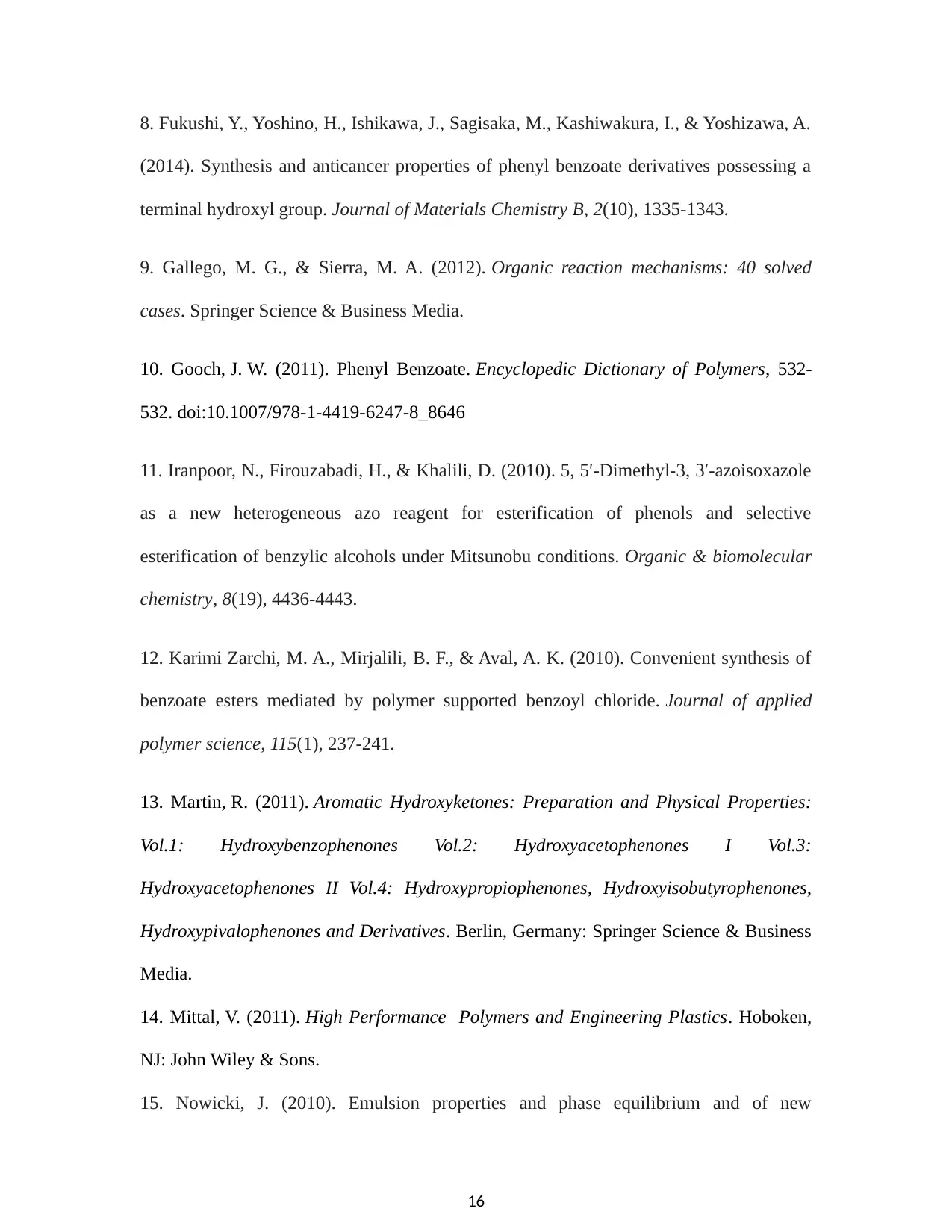
8. Fukushi, Y., Yoshino, H., Ishikawa, J., Sagisaka, M., Kashiwakura, I., & Yoshizawa, A.
(2014). Synthesis and anticancer properties of phenyl benzoate derivatives possessing a
terminal hydroxyl group. Journal of Materials Chemistry B, 2(10), 1335-1343.
9. Gallego, M. G., & Sierra, M. A. (2012). Organic reaction mechanisms: 40 solved
cases. Springer Science & Business Media.
10. Gooch, J. W. (2011). Phenyl Benzoate. Encyclopedic Dictionary of Polymers, 532-
532. doi:10.1007/978-1-4419-6247-8_8646
11. Iranpoor, N., Firouzabadi, H., & Khalili, D. (2010). 5, 5′-Dimethyl-3, 3′-azoisoxazole
as a new heterogeneous azo reagent for esterification of phenols and selective
esterification of benzylic alcohols under Mitsunobu conditions. Organic & biomolecular
chemistry, 8(19), 4436-4443.
12. Karimi Zarchi, M. A., Mirjalili, B. F., & Aval, A. K. (2010). Convenient synthesis of
benzoate esters mediated by polymer supported benzoyl chloride. Journal of applied
polymer science, 115(1), 237-241.
13. Martin, R. (2011). Aromatic Hydroxyketones: Preparation and Physical Properties:
Vol.1: Hydroxybenzophenones Vol.2: Hydroxyacetophenones I Vol.3:
Hydroxyacetophenones II Vol.4: Hydroxypropiophenones, Hydroxyisobutyrophenones,
Hydroxypivalophenones and Derivatives. Berlin, Germany: Springer Science & Business
Media.
14. Mittal, V. (2011). High Performance Polymers and Engineering Plastics. Hoboken,
NJ: John Wiley & Sons.
15. Nowicki, J. (2010). Emulsion properties and phase equilibrium and of new
16
(2014). Synthesis and anticancer properties of phenyl benzoate derivatives possessing a
terminal hydroxyl group. Journal of Materials Chemistry B, 2(10), 1335-1343.
9. Gallego, M. G., & Sierra, M. A. (2012). Organic reaction mechanisms: 40 solved
cases. Springer Science & Business Media.
10. Gooch, J. W. (2011). Phenyl Benzoate. Encyclopedic Dictionary of Polymers, 532-
532. doi:10.1007/978-1-4419-6247-8_8646
11. Iranpoor, N., Firouzabadi, H., & Khalili, D. (2010). 5, 5′-Dimethyl-3, 3′-azoisoxazole
as a new heterogeneous azo reagent for esterification of phenols and selective
esterification of benzylic alcohols under Mitsunobu conditions. Organic & biomolecular
chemistry, 8(19), 4436-4443.
12. Karimi Zarchi, M. A., Mirjalili, B. F., & Aval, A. K. (2010). Convenient synthesis of
benzoate esters mediated by polymer supported benzoyl chloride. Journal of applied
polymer science, 115(1), 237-241.
13. Martin, R. (2011). Aromatic Hydroxyketones: Preparation and Physical Properties:
Vol.1: Hydroxybenzophenones Vol.2: Hydroxyacetophenones I Vol.3:
Hydroxyacetophenones II Vol.4: Hydroxypropiophenones, Hydroxyisobutyrophenones,
Hydroxypivalophenones and Derivatives. Berlin, Germany: Springer Science & Business
Media.
14. Mittal, V. (2011). High Performance Polymers and Engineering Plastics. Hoboken,
NJ: John Wiley & Sons.
15. Nowicki, J. (2010). Emulsion properties and phase equilibrium and of new
16
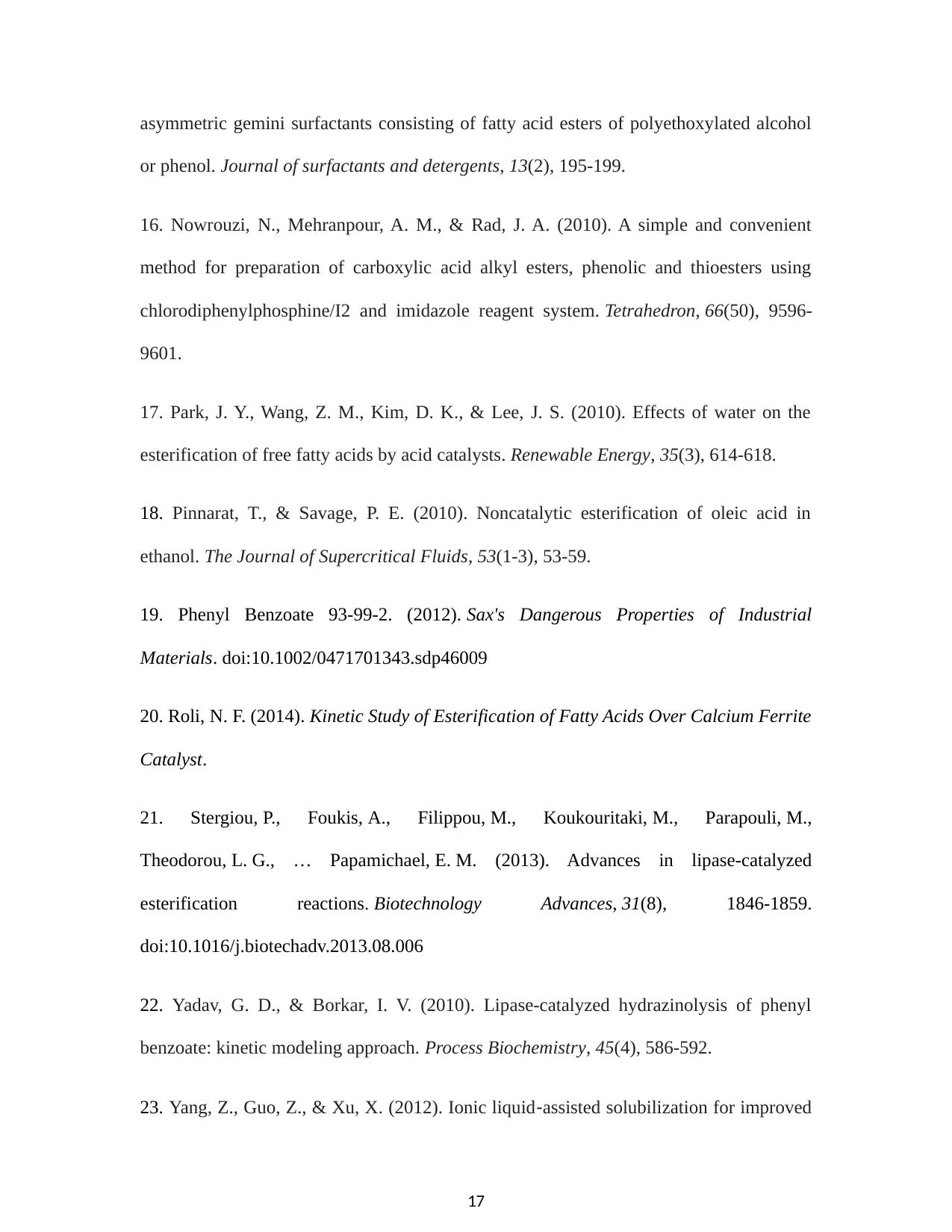
asymmetric gemini surfactants consisting of fatty acid esters of polyethoxylated alcohol
or phenol. Journal of surfactants and detergents, 13(2), 195-199.
16. Nowrouzi, N., Mehranpour, A. M., & Rad, J. A. (2010). A simple and convenient
method for preparation of carboxylic acid alkyl esters, phenolic and thioesters using
chlorodiphenylphosphine/I2 and imidazole reagent system. Tetrahedron, 66(50), 9596-
9601.
17. Park, J. Y., Wang, Z. M., Kim, D. K., & Lee, J. S. (2010). Effects of water on the
esterification of free fatty acids by acid catalysts. Renewable Energy, 35(3), 614-618.
18. Pinnarat, T., & Savage, P. E. (2010). Noncatalytic esterification of oleic acid in
ethanol. The Journal of Supercritical Fluids, 53(1-3), 53-59.
19. Phenyl Benzoate 93-99-2. (2012). Sax's Dangerous Properties of Industrial
Materials. doi:10.1002/0471701343.sdp46009
20. Roli, N. F. (2014). Kinetic Study of Esterification of Fatty Acids Over Calcium Ferrite
Catalyst.
21. Stergiou, P., Foukis, A., Filippou, M., Koukouritaki, M., Parapouli, M.,
Theodorou, L. G., … Papamichael, E. M. (2013). Advances in lipase-catalyzed
esterification reactions. Biotechnology Advances, 31(8), 1846-1859.
doi:10.1016/j.biotechadv.2013.08.006
22. Yadav, G. D., & Borkar, I. V. (2010). Lipase-catalyzed hydrazinolysis of phenyl
benzoate: kinetic modeling approach. Process Biochemistry, 45(4), 586-592.
23. Yang, Z., Guo, Z., & Xu, X. (2012). Ionic liquid‐assisted solubilization for improved
17
or phenol. Journal of surfactants and detergents, 13(2), 195-199.
16. Nowrouzi, N., Mehranpour, A. M., & Rad, J. A. (2010). A simple and convenient
method for preparation of carboxylic acid alkyl esters, phenolic and thioesters using
chlorodiphenylphosphine/I2 and imidazole reagent system. Tetrahedron, 66(50), 9596-
9601.
17. Park, J. Y., Wang, Z. M., Kim, D. K., & Lee, J. S. (2010). Effects of water on the
esterification of free fatty acids by acid catalysts. Renewable Energy, 35(3), 614-618.
18. Pinnarat, T., & Savage, P. E. (2010). Noncatalytic esterification of oleic acid in
ethanol. The Journal of Supercritical Fluids, 53(1-3), 53-59.
19. Phenyl Benzoate 93-99-2. (2012). Sax's Dangerous Properties of Industrial
Materials. doi:10.1002/0471701343.sdp46009
20. Roli, N. F. (2014). Kinetic Study of Esterification of Fatty Acids Over Calcium Ferrite
Catalyst.
21. Stergiou, P., Foukis, A., Filippou, M., Koukouritaki, M., Parapouli, M.,
Theodorou, L. G., … Papamichael, E. M. (2013). Advances in lipase-catalyzed
esterification reactions. Biotechnology Advances, 31(8), 1846-1859.
doi:10.1016/j.biotechadv.2013.08.006
22. Yadav, G. D., & Borkar, I. V. (2010). Lipase-catalyzed hydrazinolysis of phenyl
benzoate: kinetic modeling approach. Process Biochemistry, 45(4), 586-592.
23. Yang, Z., Guo, Z., & Xu, X. (2012). Ionic liquid‐assisted solubilization for improved
17
Paraphrase This Document
Need a fresh take? Get an instant paraphrase of this document with our AI Paraphraser

enzymatic esterification of phenolic acids. Journal of the American Oil Chemists'
Society, 89(6), 1049-1055.
24. Van Santen, R. A., Markvoort, A. J., Filot, I. A., Ghouri, M. M., & Hensen, E. J.
(2013). Mechanism and microkinetics of the Fischer–Tropsch reaction. Physical
Chemistry Chemical Physics, 15(40), 17038.
18
Society, 89(6), 1049-1055.
24. Van Santen, R. A., Markvoort, A. J., Filot, I. A., Ghouri, M. M., & Hensen, E. J.
(2013). Mechanism and microkinetics of the Fischer–Tropsch reaction. Physical
Chemistry Chemical Physics, 15(40), 17038.
18
1 out of 20
Related Documents
Your All-in-One AI-Powered Toolkit for Academic Success.
+13062052269
info@desklib.com
Available 24*7 on WhatsApp / Email
![[object Object]](/_next/static/media/star-bottom.7253800d.svg)
Unlock your academic potential
© 2024 | Zucol Services PVT LTD | All rights reserved.





